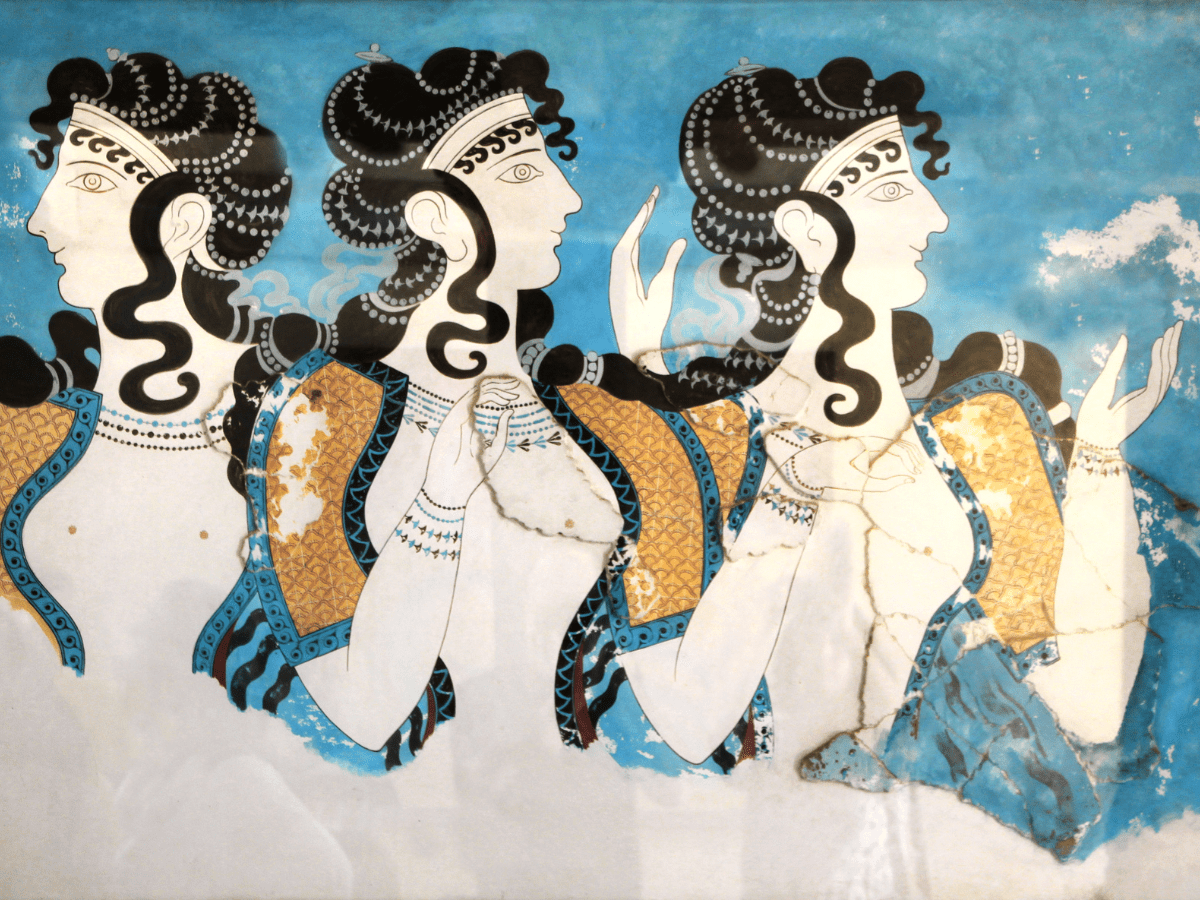The Heraklion Archaeological Museum
The Heraklion Archaeological Museum (AHM) in Heraklion, Crete, is one of the best museums in Greece and holds most of the artefacts from the Minoan palace at Knossos and other Minoan sites in Crete.
The Minoan palace at Knossos is the second most visited site in Greece, and while all those tourists might not go to the Heraklion Archaeological Museum, it was bustling. Also, it has 27 rooms. I made my way through it slowly, patiently behind other tourists, waiting for them to move on to get closer to the artefacts, read their descriptions, and snap the best photos I could of beautiful objects, often behind glass. My husband and I spent a few hours there and were exhausted by the end; he dozed off in a chair belonging to one of the museum guardians. And yet I didn’t see everything or spend as much time with some artefacts as I would have liked.
The exhibition itinerary starts on the ground floor with the Minoan Collection, continues to the first floor with the frescoes and the historic period, and ends back on the ground floor with the Sculpture Collection. In this blog entry, I’m not following the itinerary. Instead, I’m sharing some of my favourite pieces, mostly related to Minoan religion.
The Minoan Snake Goddess is not the first artefact in the museum. Following the floor plan, you’ll find her in the eighth room at the back of the ground floor. Despite my excitement, I didn’t run to see her. I was happy to follow the exhibition itinerary and let the anticipation build as I learned more about the incredible Minoan civilisation. But since seeing her was my highlight, and I dedicate November to her, let’s start with the Minoan Snake Goddess.
Who is the Minoan Snake Goddess?
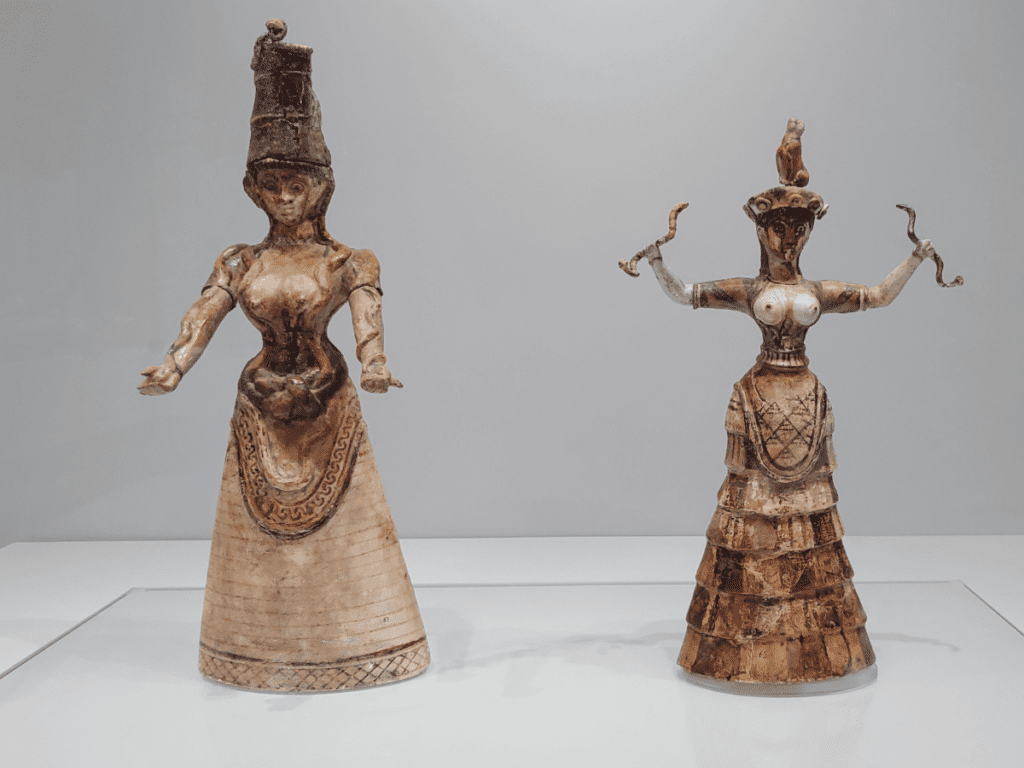
“Minoan Snake Goddess” refers to two figures that Sir Arthur Evans found in an area that he called the “Temple Repositories” because they contained objects that were, presumably, no longer in use.
Evans found the figures in fragments. The larger of the two figures was missing her body below the waist, one arm, and part of the crown. The smaller of the two figures was missing her head and left arm. A third comparable figure was missing her body above the waist. Evans called the larger one the Snake Goddess and the smaller one the Snake Priestess.
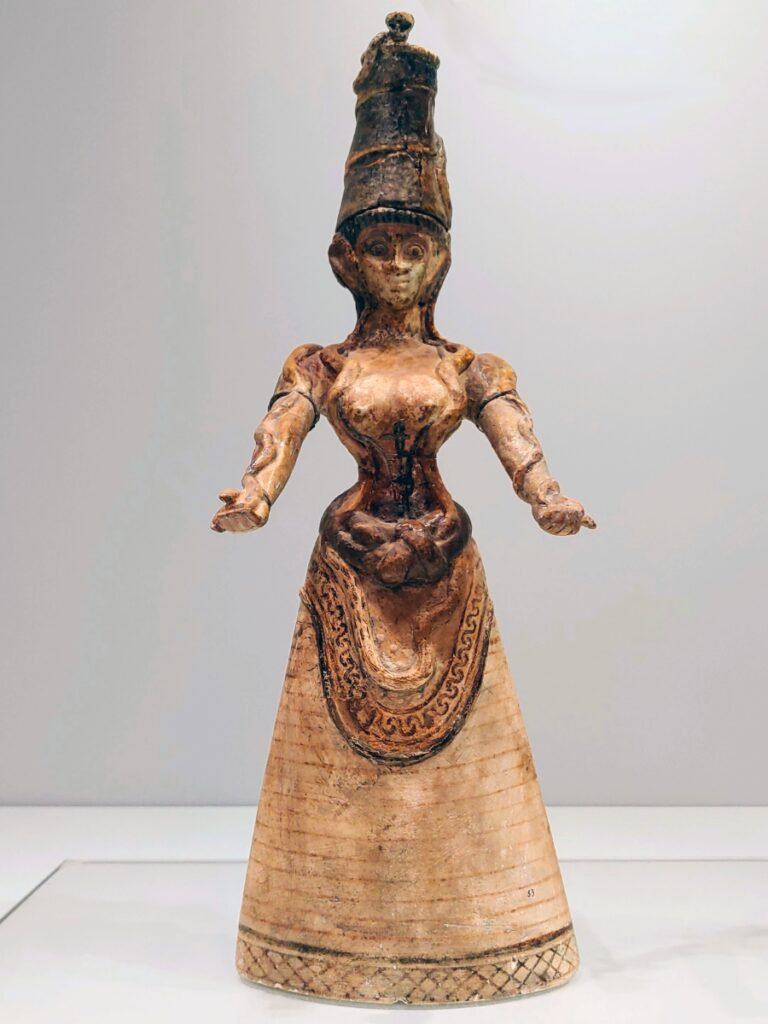
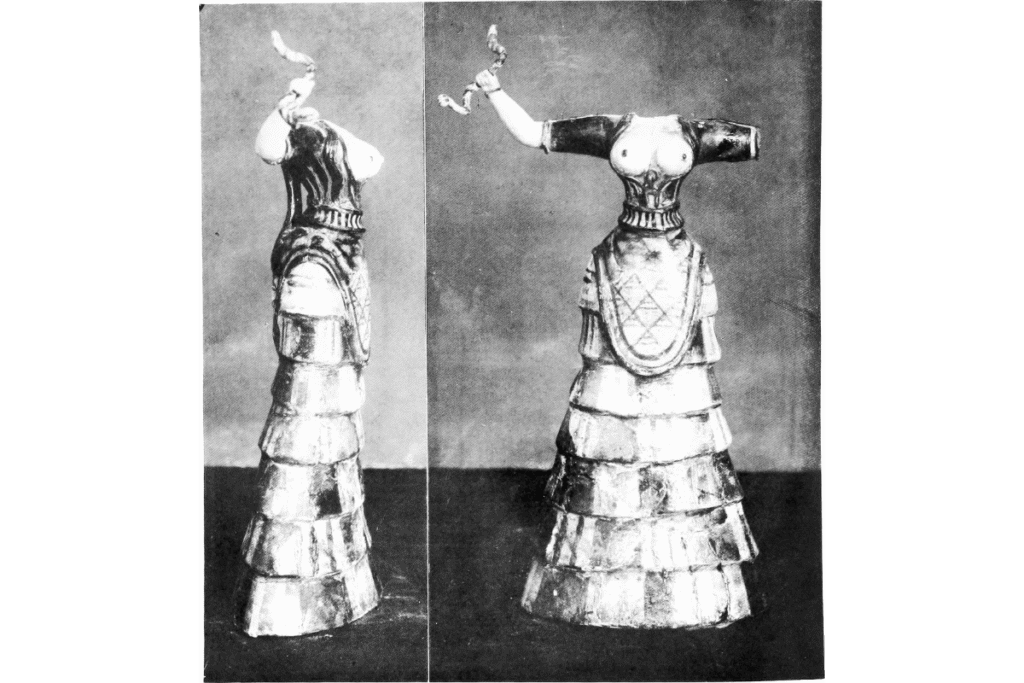
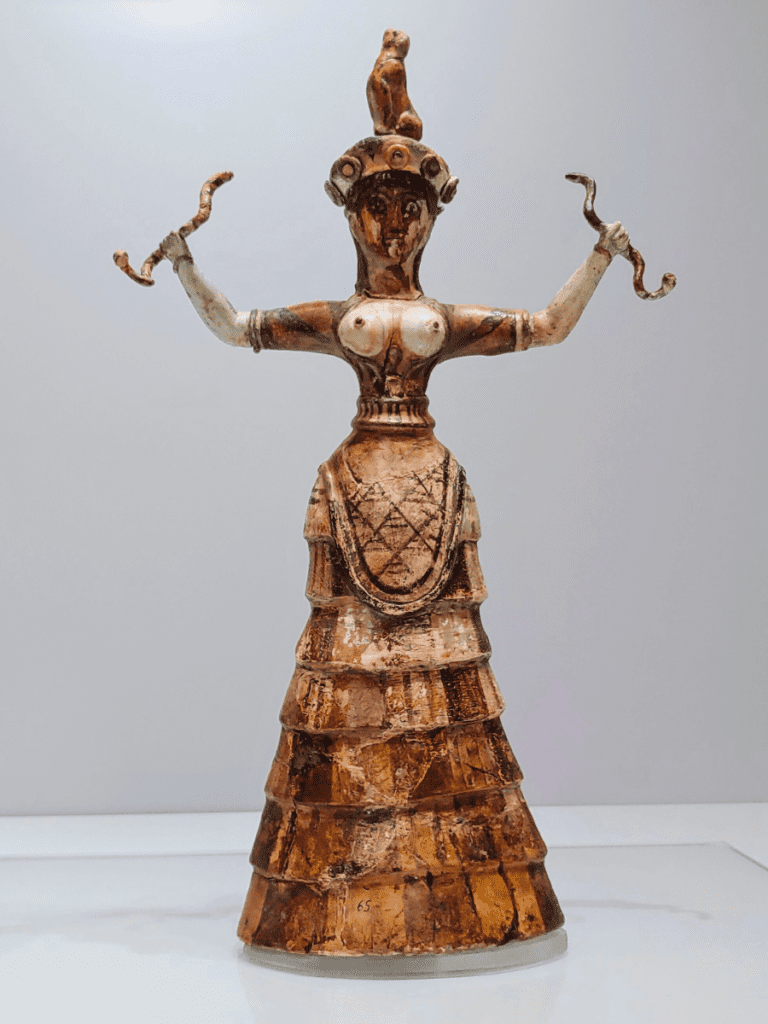
Although I consider these figures goddesses, and I have ideas about who they are, the historical fact is that we don’t know. We’re not even sure what they looked like. In the case of the second figure, in his restoration of her, Evans added a crown and a feline creature. Museum information presents the figures as they are, with Evans’ restorations and interpretations as facts rather than possibilities. The audio tour adds that the feline may be a cat or a panther. It asserts that the figures are identified with the “Earth Goddess” or her priestess performing a snake dance in a ritual connected with the coming of spring and rejuvenation of nature. But it has to be noted that we don’t know.
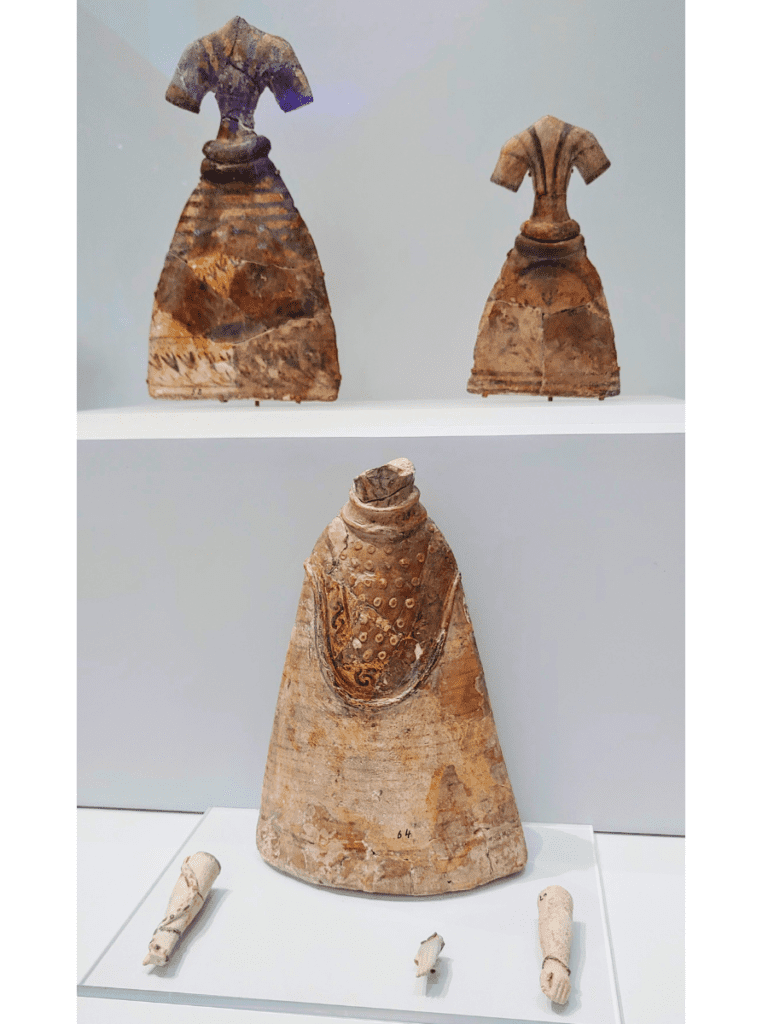
Archaeologists found two relief plaques of models of female garments (shown above) with the Snake Goddess figurines and other votive and ritual objects in the Temple Repositories of Knossos.
I was very excited to see the Minoan Snake Goddess figurines. I first came across her image on the cover of When God Was a Woman by Merlin Stone when I was in high school. That book blew my teenage mind, and it was incredible to stand in front of her 30 years later. The serpent is one of my spirit animals, and to me, she is an earthy goddess of rebirth and regeneration, an important theme in my life.
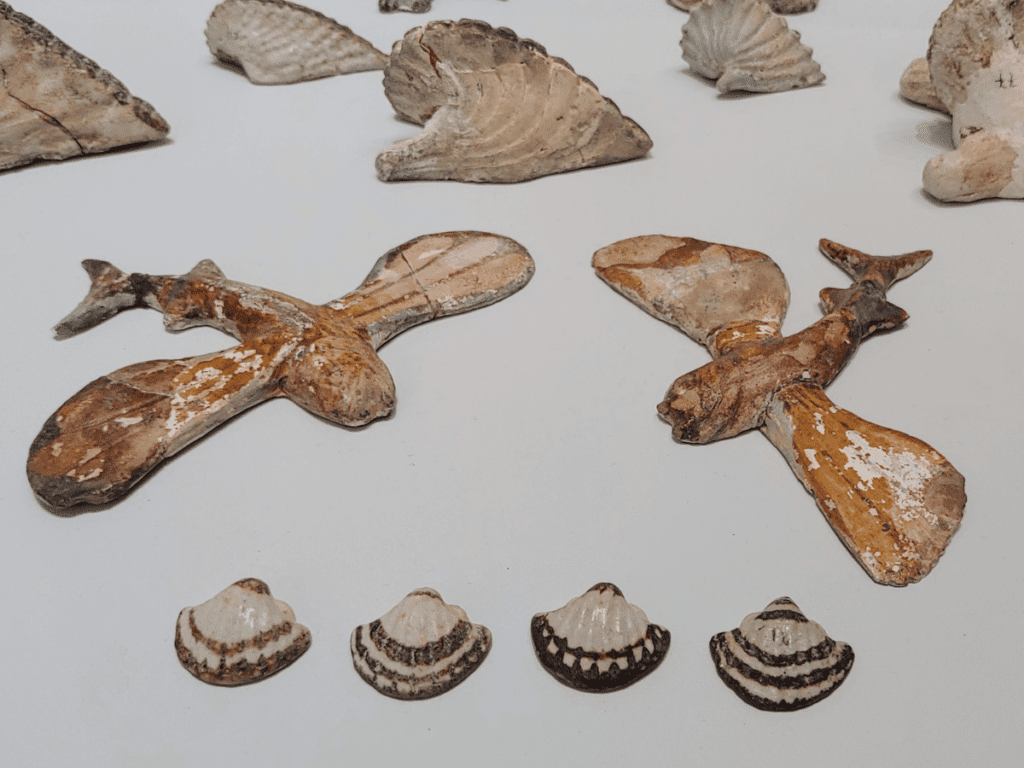
Archaeologists found models of flying fish and seashells in the Temple Repositories with the Snake Goddess figurines. The flying fish have flat backs and were probably relief inlays or hung on walls. Some seashells are three-dimensional models.
Other Minoan deities
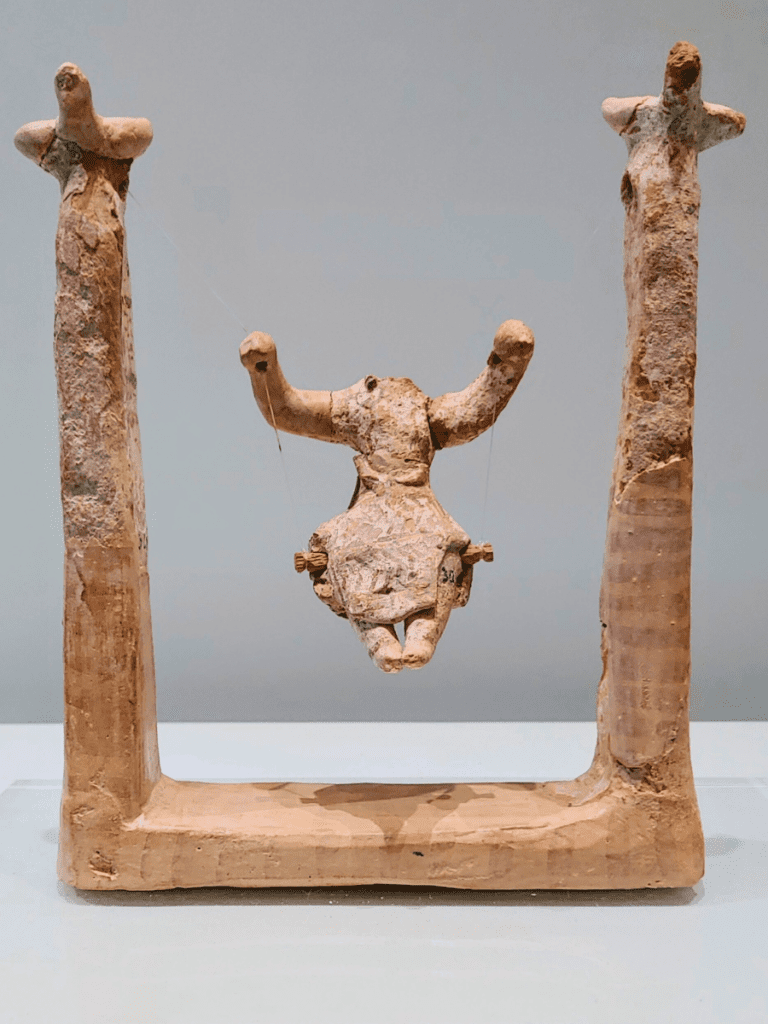
This fascinating clay model shows a female figure swinking between two posts crowned with birds. The museum description says that the Swing was identified initially as a ceremonial ritual. However, now she is believed to be an image of the descent of the goddess, whose presence is often accompanied by birds (doves) with open wings.
Evans thought that the Minoans worshipped a mother goddess more or less exclusively. The image of the Snake Goddess as the only or primary goddess of the Minoans has stayed with us. However, the Minoan pantheon featured many deities.
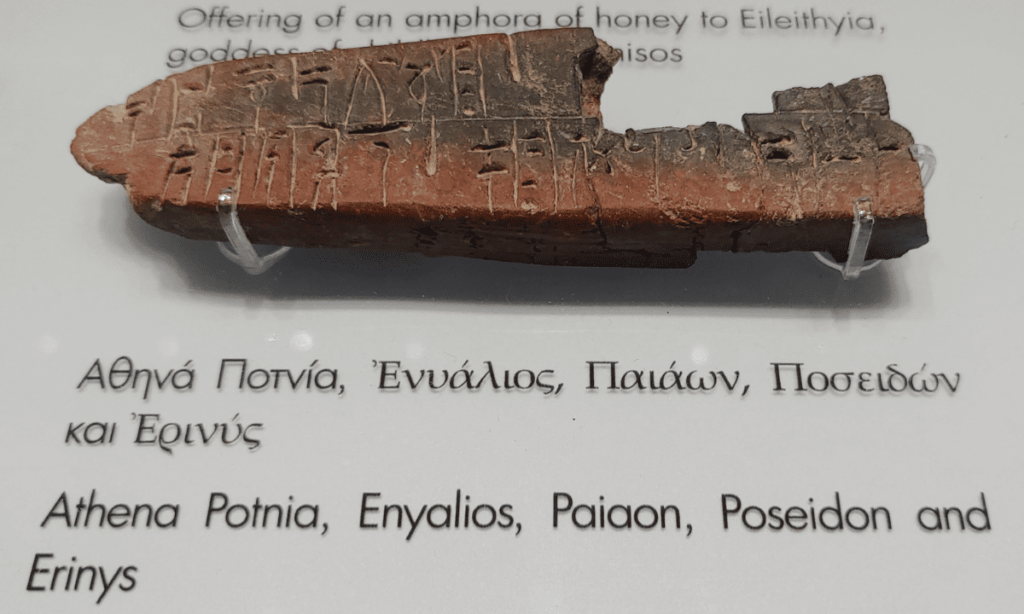
This clay tablet was found in the Palace of Knossos and dates to the Final Palatial period of the Late Minoan era. By then, the glory days of the Minoan civilisation were over. Among the palaces, only Knossos remained in use, and Crete was under the cultural and political domination of the mainland Mycenaean Greeks. The language of administration had shifted to Mycenaean Greek.
The Minoans had writing: Cretan hieroglyphics and Linear A script, but neither has been deciphered. Linear B, a script used in Mycenaean Greek writing, is descended from Linear A and gives us insight into Minoan writing.
The inscriptions on this Linear B tablet refer to some deities: Athena(?) Potnia, Enyalios, Paeaon, Poseidon, and Erinys. Scholar Martin P. Nilsson proposed that the origin of Athena was the Minoan snake goddess. Still, it’s hard to know precisely how the Minoans and Myceneans influenced each other and to what extent their religions can be differentiated.
In addition to the names we recognise as Greek deities, archaeologists have also identified a mountain goddess, a dove goddess, the Potnia Theron goddess of animals, and a distinctive type of large female terracotta figurine with upraised arms.
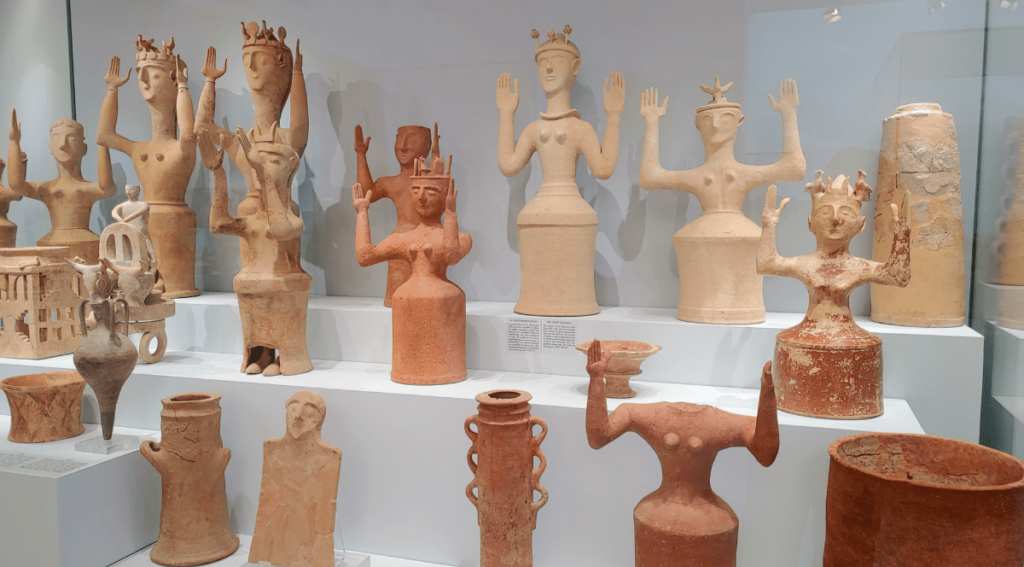
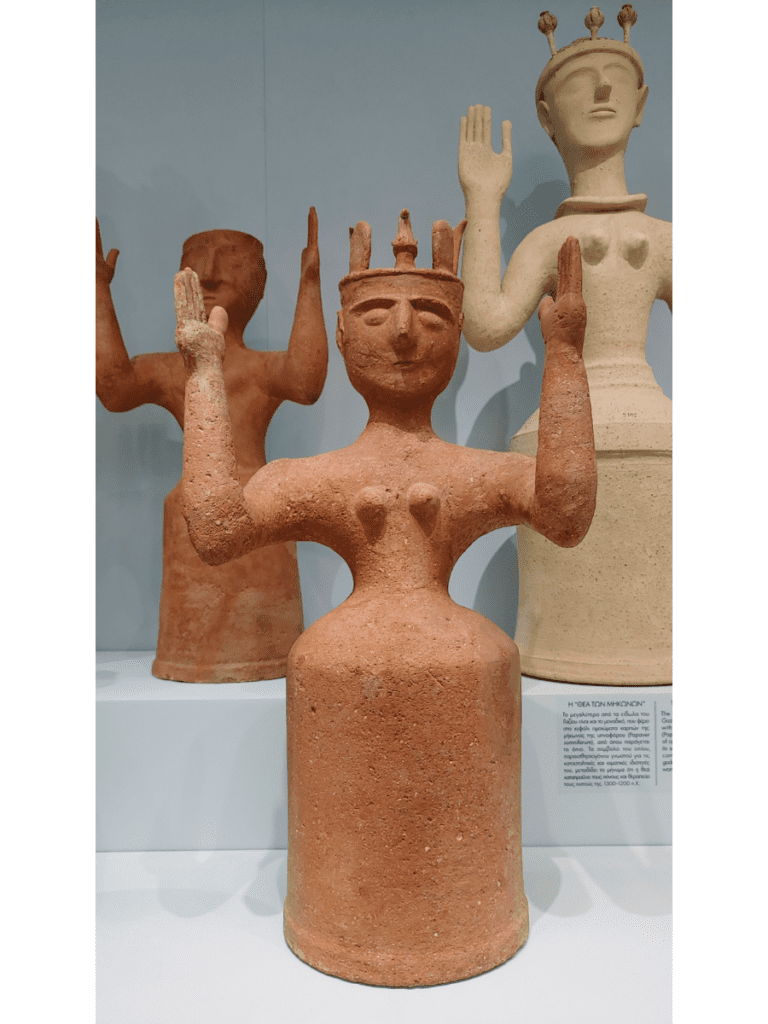
The “goddess with upraised arms” is a type of female figure with, you guessed it, raised arms; the elbows are bent at right angles. They consist of three separate parts (head, torso, cylindrical garment) joined together with clay. In some cases, the hem of the hollow cylindrical skirt is interrupted to reveal a pair of feet. They have diadems and symbols, including birds, snakes, horns of consecration, and poppy heads (these variants are referred to as the Poppy Goddess).
These figures have been found mainly in community sanctuaries of Postpalatial settlements (1300-1070 BC) and are believed to represent priestesses or goddesses.

The “goddess with upraised arms” shown above in the centre is my favourite. She has horns of consecration, and I love the expression on her face.
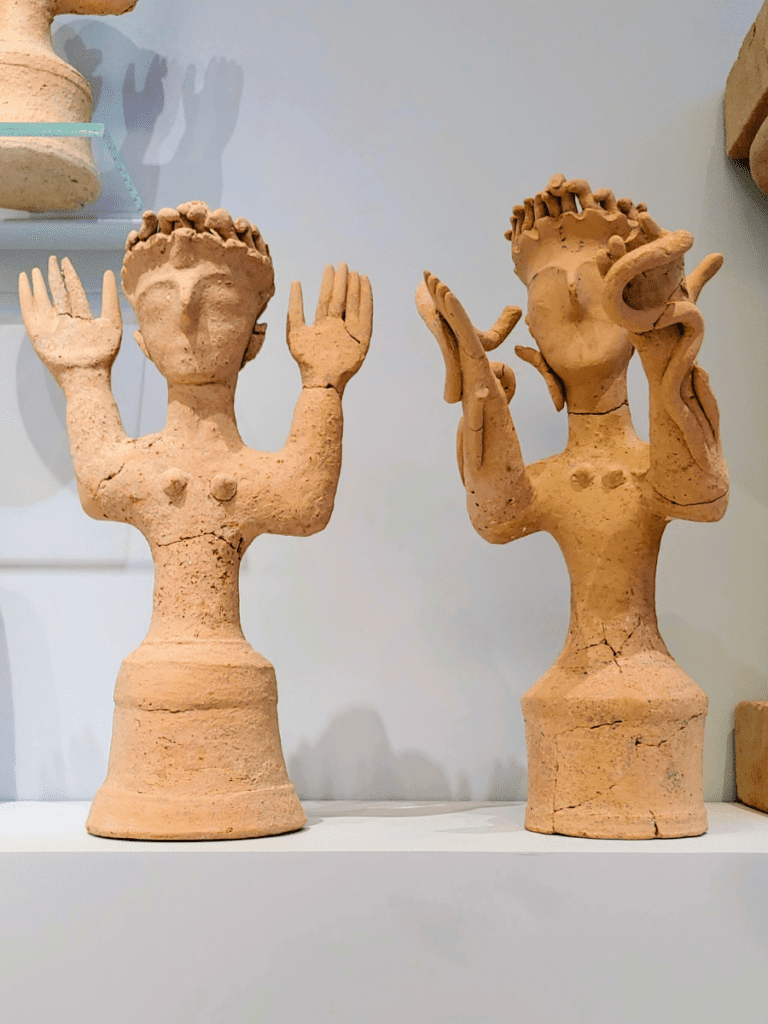
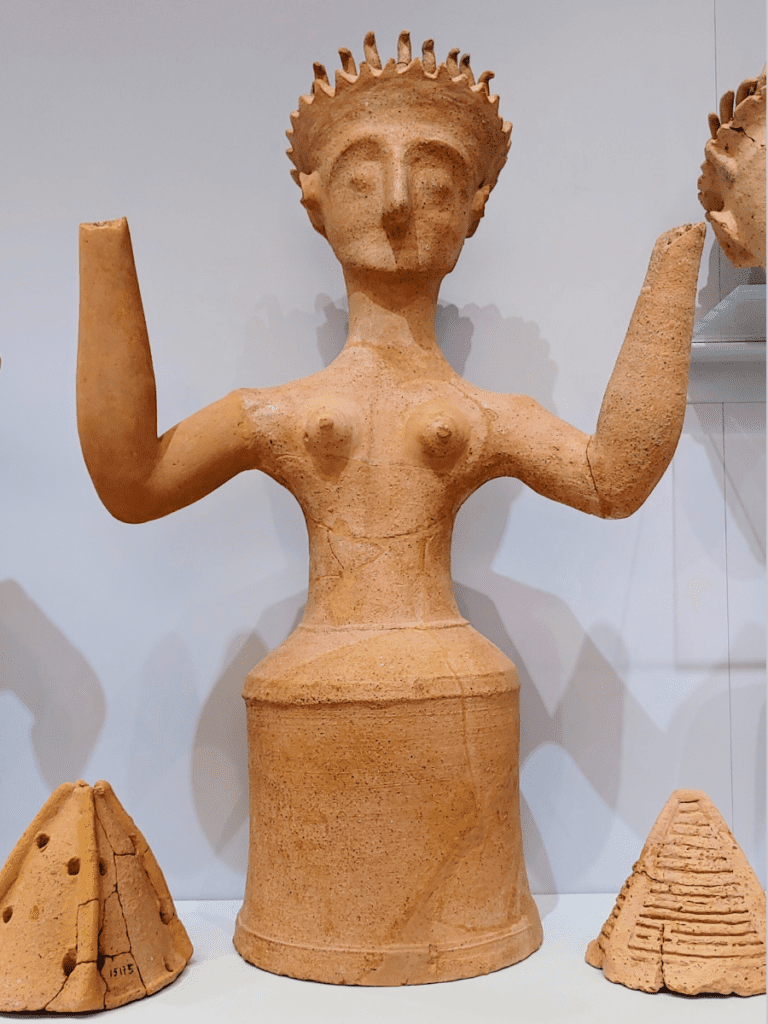
This fascinating clay model shows a female figure swinking between two posts crowned with birds. The museum description says that the Swing was identified initially as a ceremonial ritual. However, now she is believed to be an image of the descent of the goddess, whose presence is often announced or accompanied by birds with open wings. Italian archaeologist Nicola Cucuzza proposes that she may be a child goddess.
Evans thought that the Minoans worshipped a mother goddess more or less exclusively. The image of the Snake Goddess as the only or primary goddess of the Minoans has stayed with us. However, archaeologists have identified a mountain goddess, a dove goddess, the Potnia Theron goddess of animals, and a distinctive type of large female terracotta figurine with upraised arms.
Sacral knot
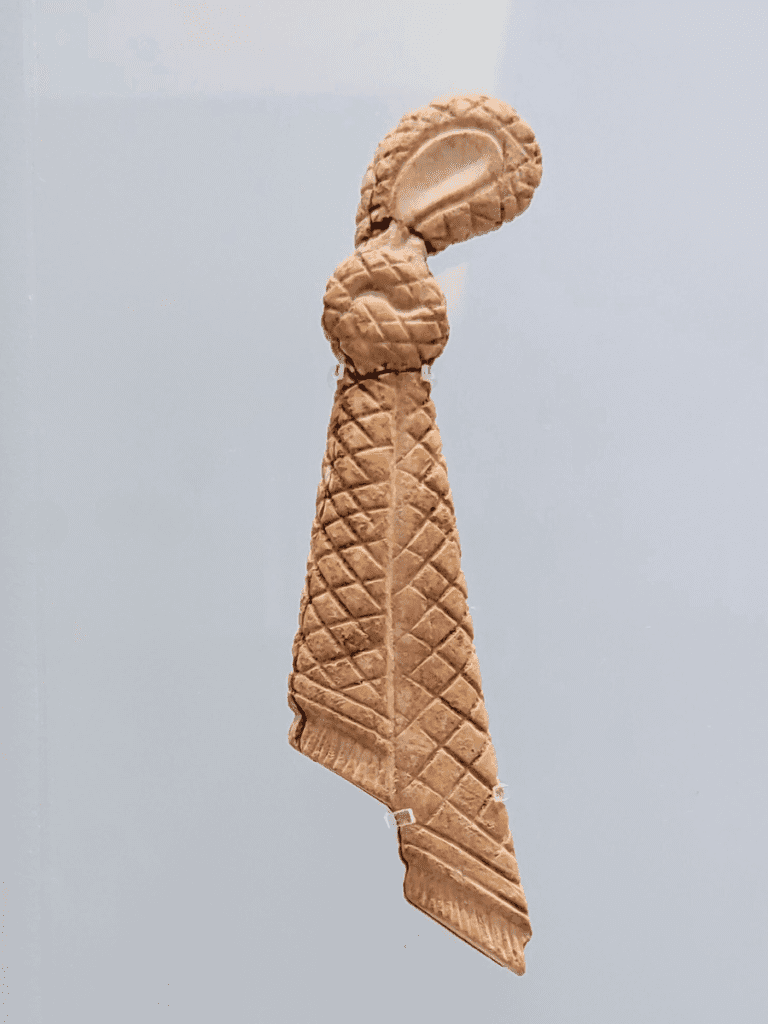
According to the museum, the sacral knot refers to a piece of cloth, such as a scarf, knotted to form a noose with free-hanging ends. It appears in various Minoan frescos, seals, and vase paintings attached to garments of female figures participating in religious ceremonies. For example, the Snake Goddess figurines wear a sacral knot, as does the figure in the fresco known as La Parisienne. It may have been a distinguishing mark of priestesses.
The sacral knot wasn’t just worn. Sacral knots made of faience, bone, and ivory decorated objects, hung in homes and were placed on graves.
Ritual gestures and elaborate hairstyles
The bronze figurines, which range from about 5 cm (2 inches) to 15 cm (6 inches), depict worshippers in characteristic gestures of adoration. The Minoans offered these types of figurines as votive offerings at shrines. They have been found in large numbers in sacred caves and peak sanctuaries, but some have also been found in settlements, suggesting they were part of domestic shrines or rituals.

The two male figurines perform a ritual gesture known as the Minoan salute.

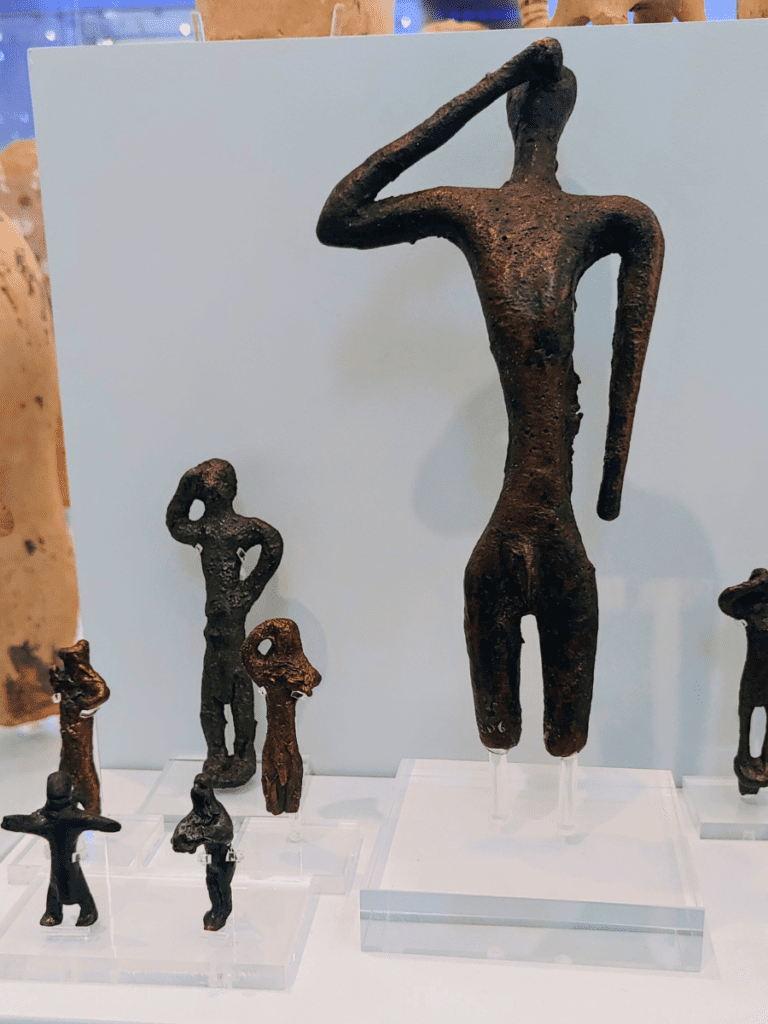
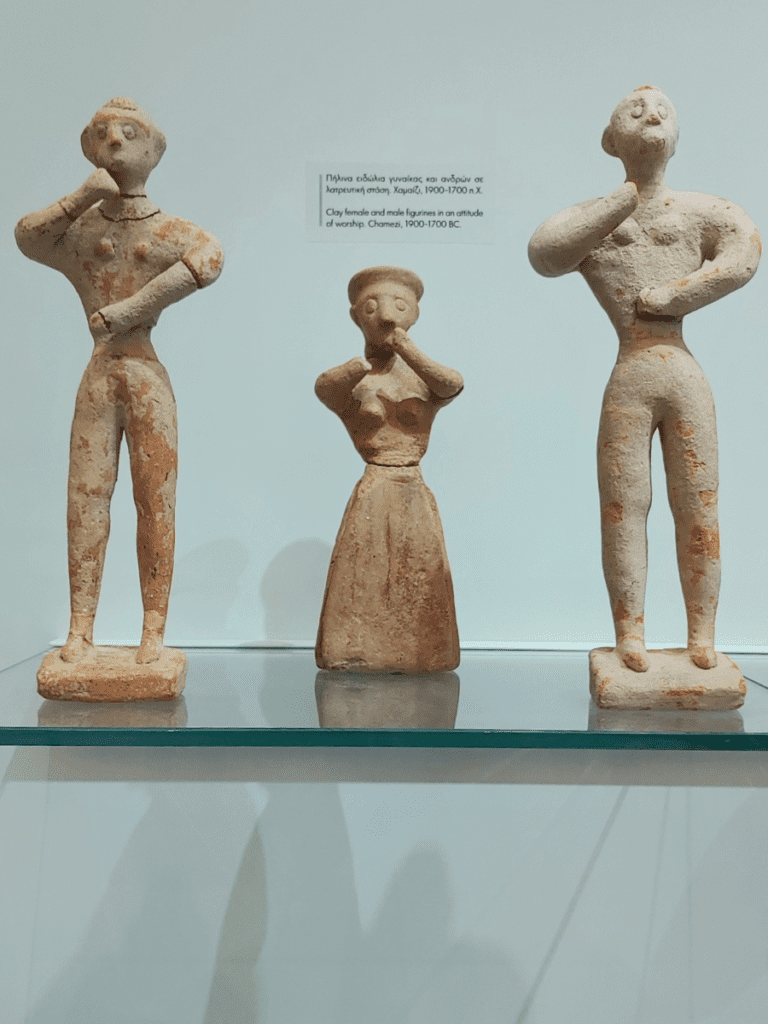
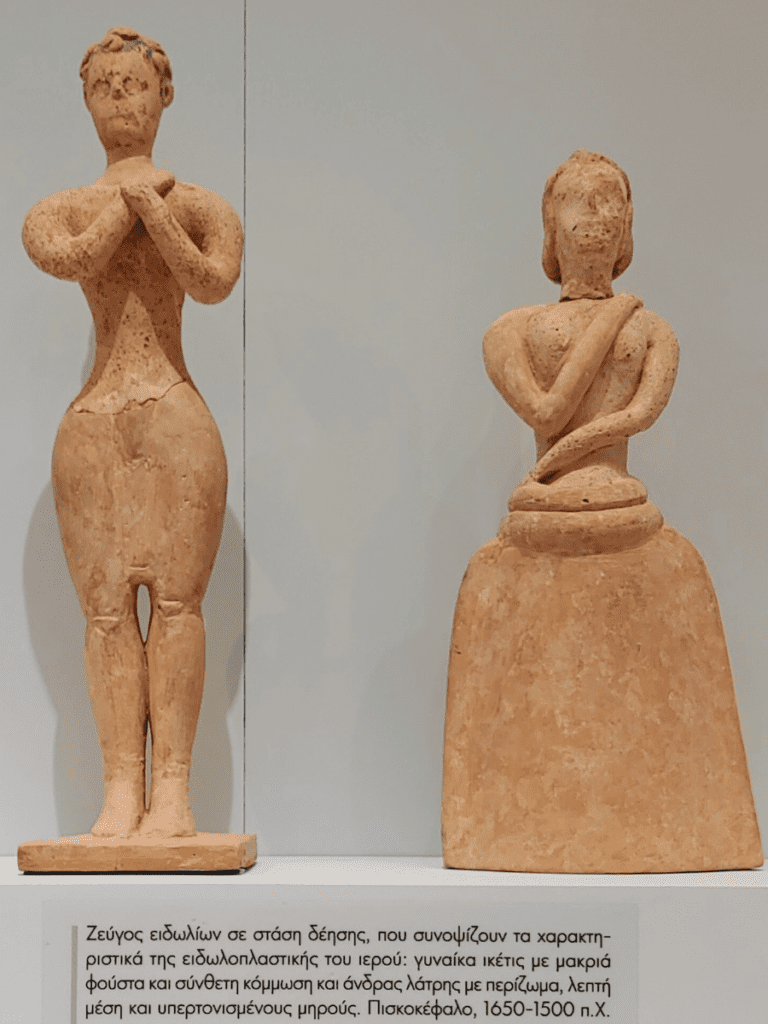
The museum description of the clay female figurine shown above notes that great emphasis is placed on the elaborate hairstyles of the female figurines from Piskokephalo, with less attention paid to the facial features. This means that the hairstyle of the women who engaged in worship was particularly important, perhaps as a mark of their social status or their role in the sanctuary ceremonies.
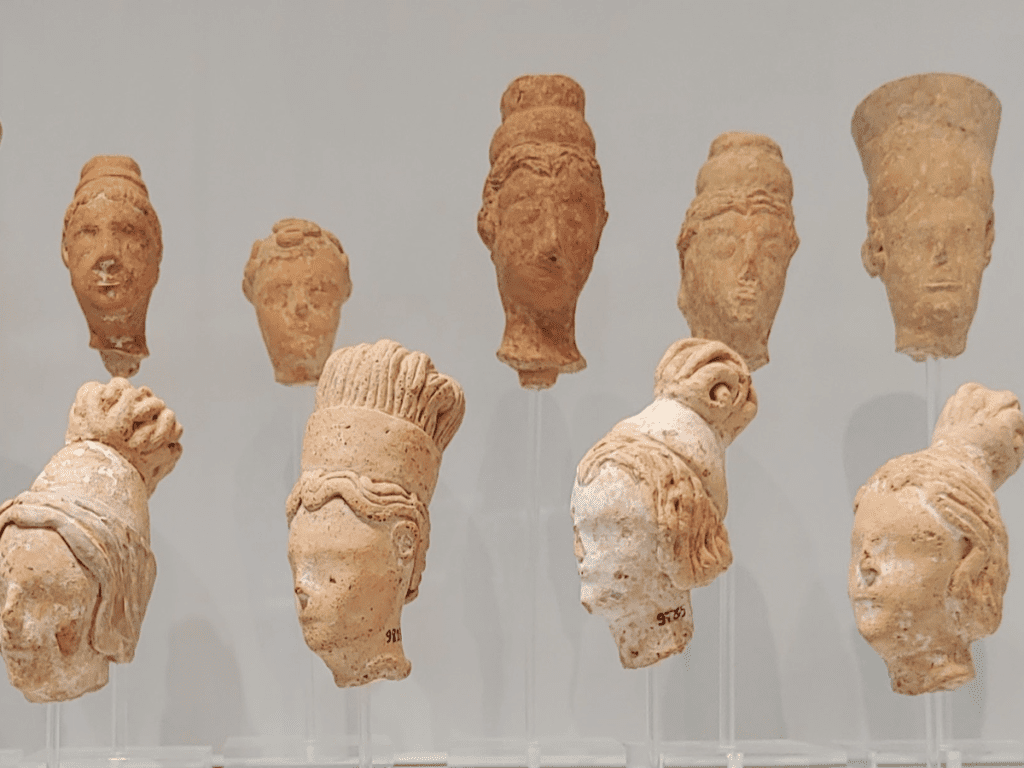
The double axe
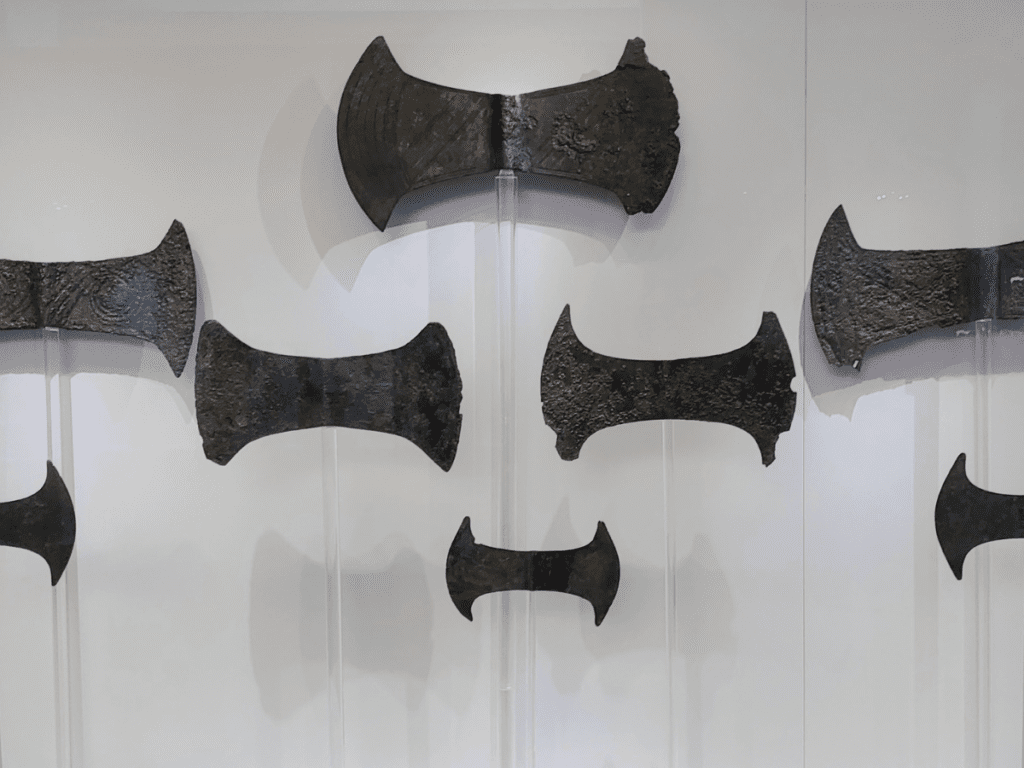
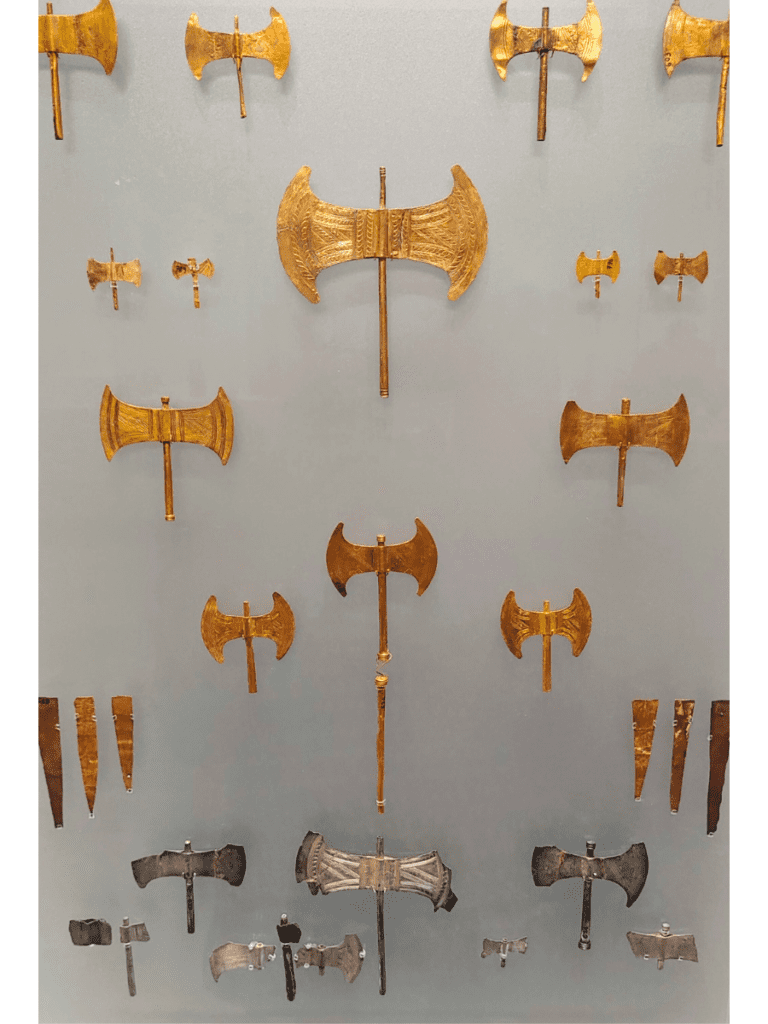
The museum has double axes ranging from 118 cm (3.8 feet) to 5 cm (2 inches) made of bronze, gold, and silver.
According to Evans, the double axes are a frequent motif symbolising reign and power. The audio tour added that double axes were associated with the sacrifice of bulls. However, other scholars have noted that, in Crete, the double axe, or labrys, was not a weapon and always accompanied female figures, presumably goddesses or priestesses, and not male figures. Further, the sacrifice of bulls does not appear to have been a typical cult activity.
There is a lot of variety among the double axes. The Minoans used double axes as tools, but the fragile construction of many of them indicates they were made to be votives and were primarily offered in cult caves. Inscribed and decorated double axes may have been heirlooms, and some were funerary offerings and possibly used in funerary rituals.
Often depicted as being carried in images of religious processions, according to one museum description, the double axe is the most important sacred symbol of the Minoan religion. In the jar below, the double axe appears with another important Minoan symbol, the bull.
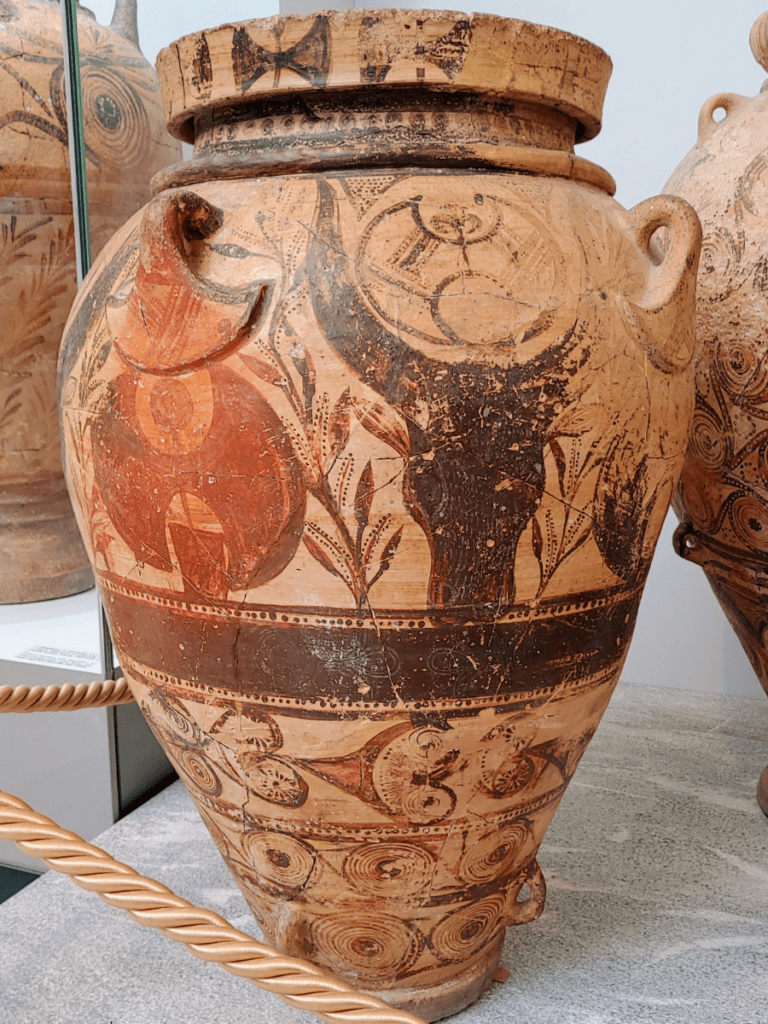
Bulls
The bull, especially its head, is the most emblematic sacred symbol of the Minoan world. Bulls and bull-leaping are common subjects in Minoan art, such as paintings, sculptures, vessels, seals, and jewellery. Evans coined the phrase “horns of consecration” for a symbol thought to represent the horns of the bull, which appears in cultic images and which the Minoans placed on the roofs of their buildings.
Still, we don’t know what bulls meant to the Minoans. Scholars don’t think the Minoans worshipped bulls, and the sacrifice of bulls doesn’t appear to have been a typical cult practice. I have explored some ideas about the Minoan’s most famous bovine figure in a previous blog entry, The Minotaur: Beauty, violence, and the forbidden.
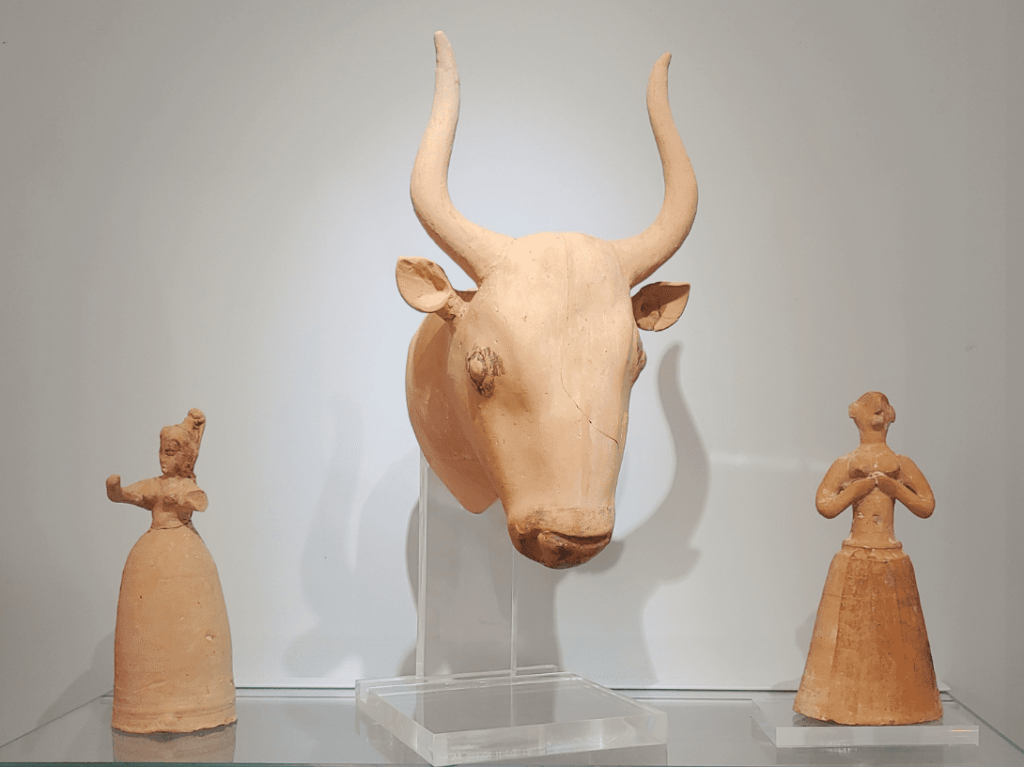
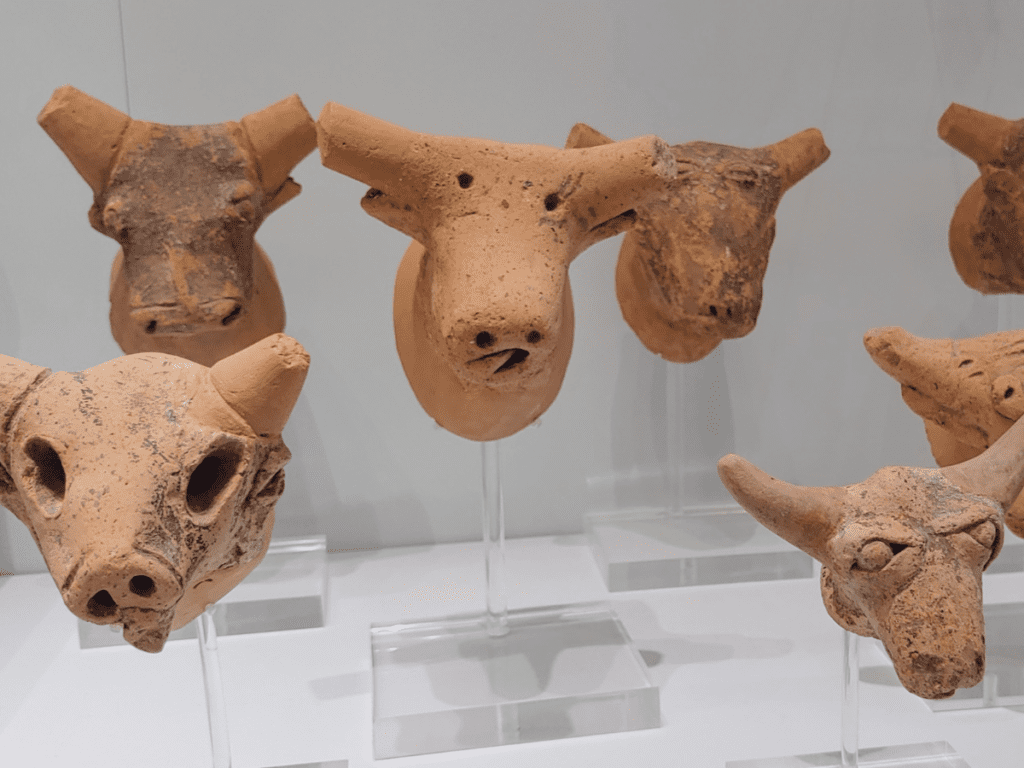
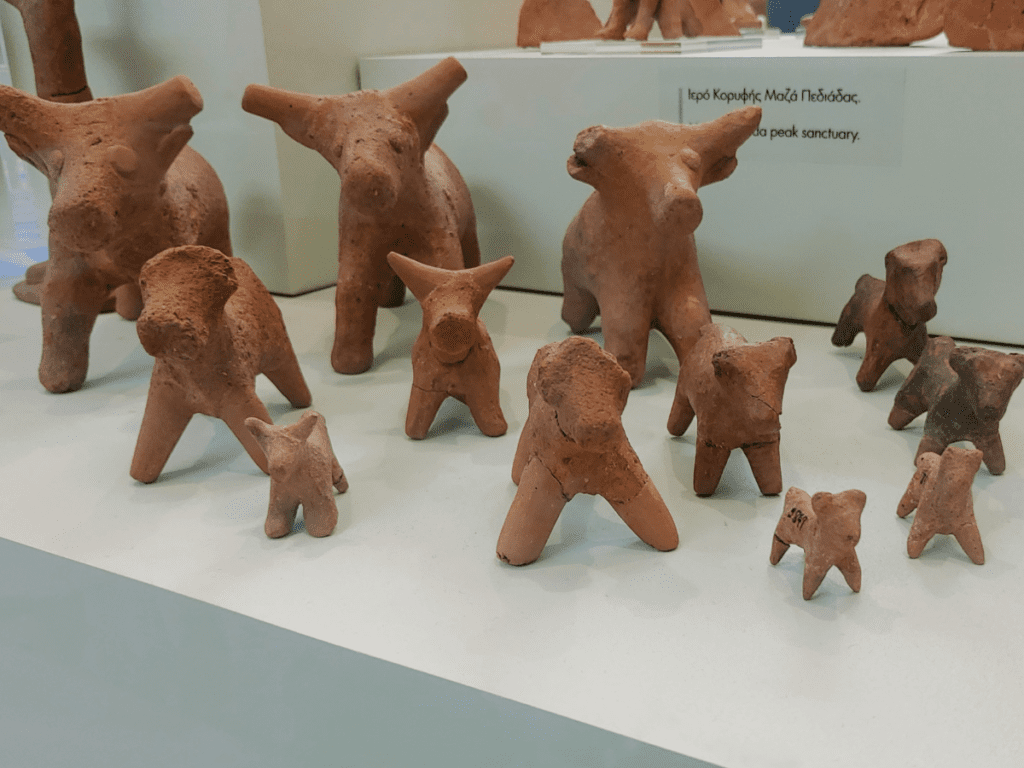
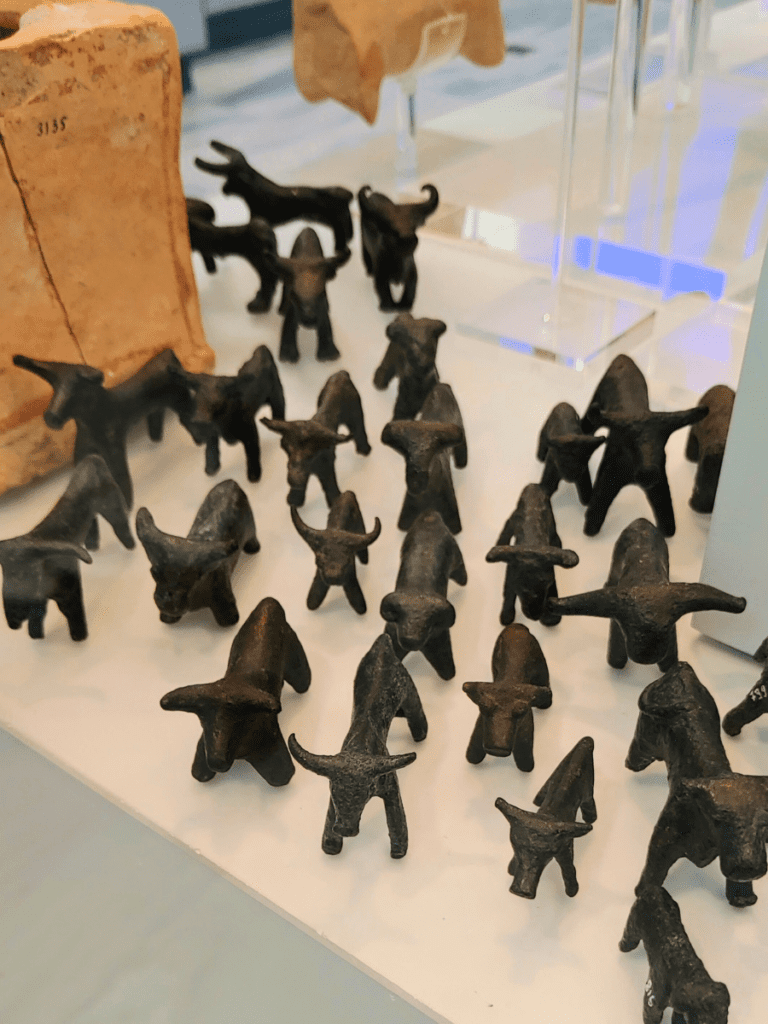
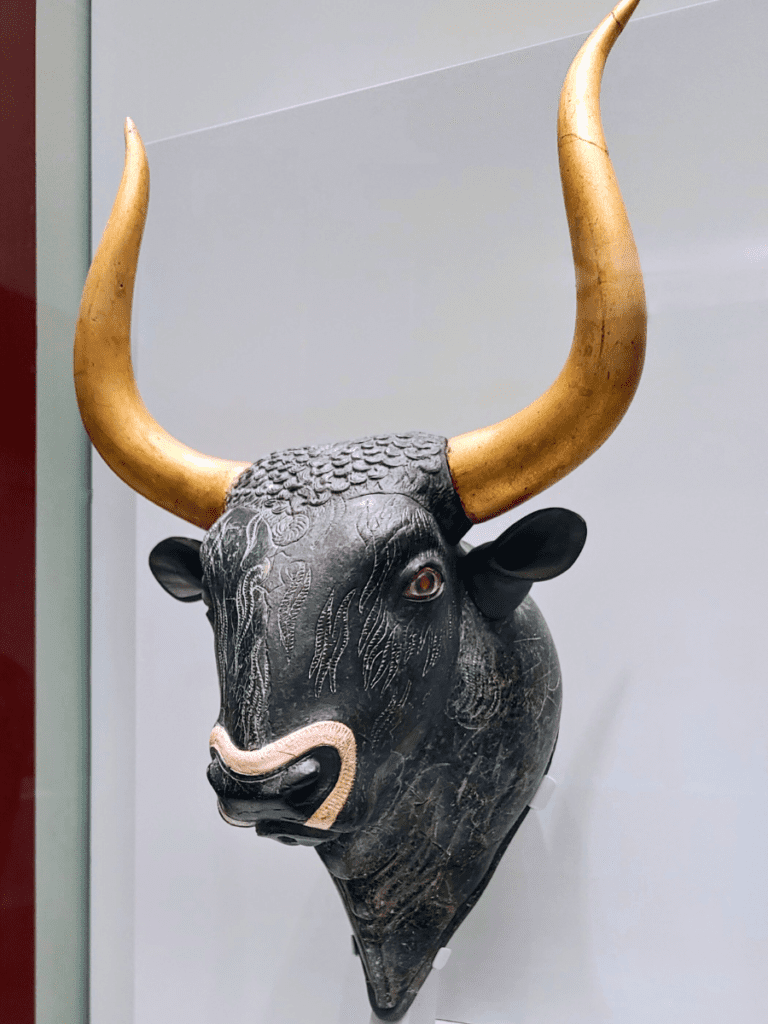
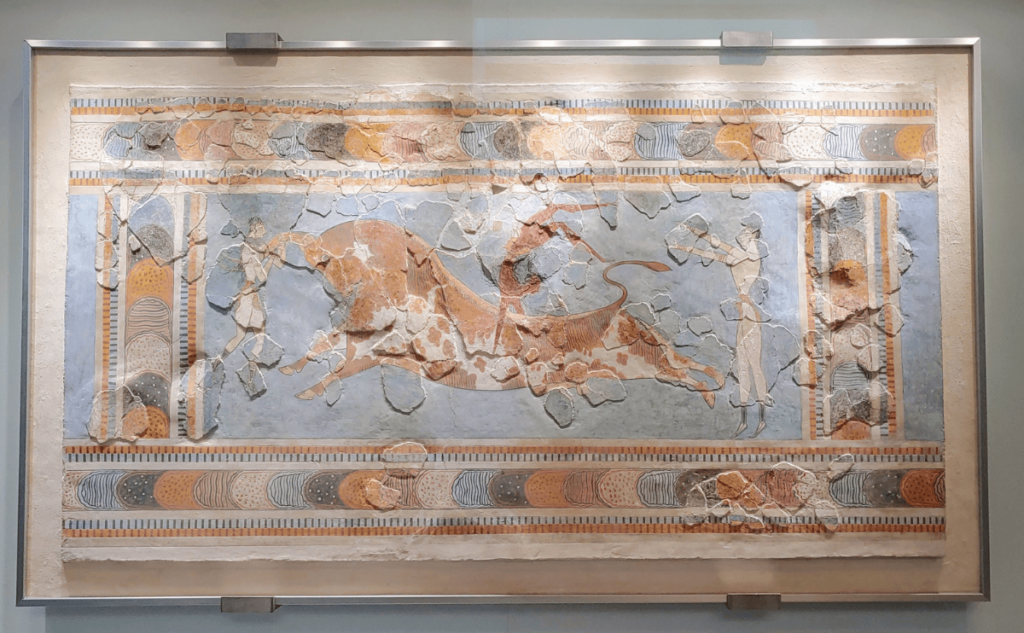
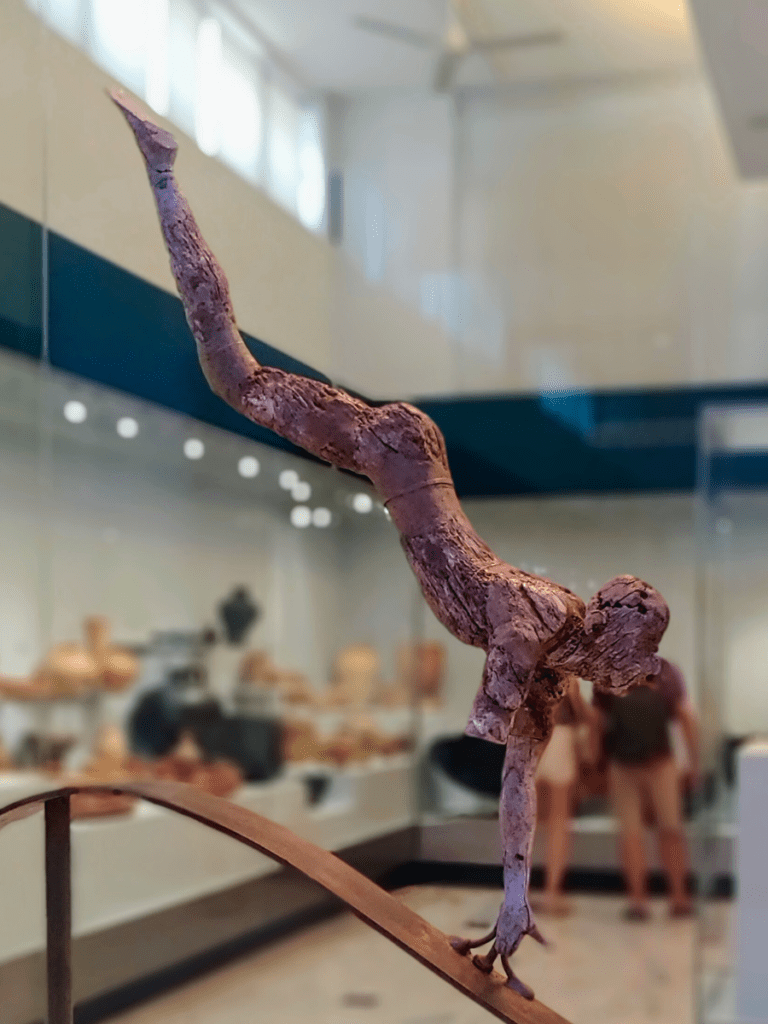
The famous bull-leaping fresco, one of my favourites, is the best preserved of at least four paintings depicting the same subject found in Knossos. It shows two women and one man (rendered in white and red, respectively) engaging in bull-leaping.
Did the Minoans practise bull-leaping as a sport, ceremonial rite, or ritual performance? We don’t know. It seems too wild to be true, and some archaeologists maintain that bull-leaping never existed as a performance and was only artistic or mythological. Other scholars believe bull-leaping may have been an actual event given the numerous depictions of it and that bull sports still happen in Spain and France, such as the course landaise in which the toreros dodge and leap over cows. (For those worried about clicking on the link to the short video and finding gory images, note that course landaise is not a blood sport, and the video does not contain images of bulls or cows being hurt.)
Bees and honey
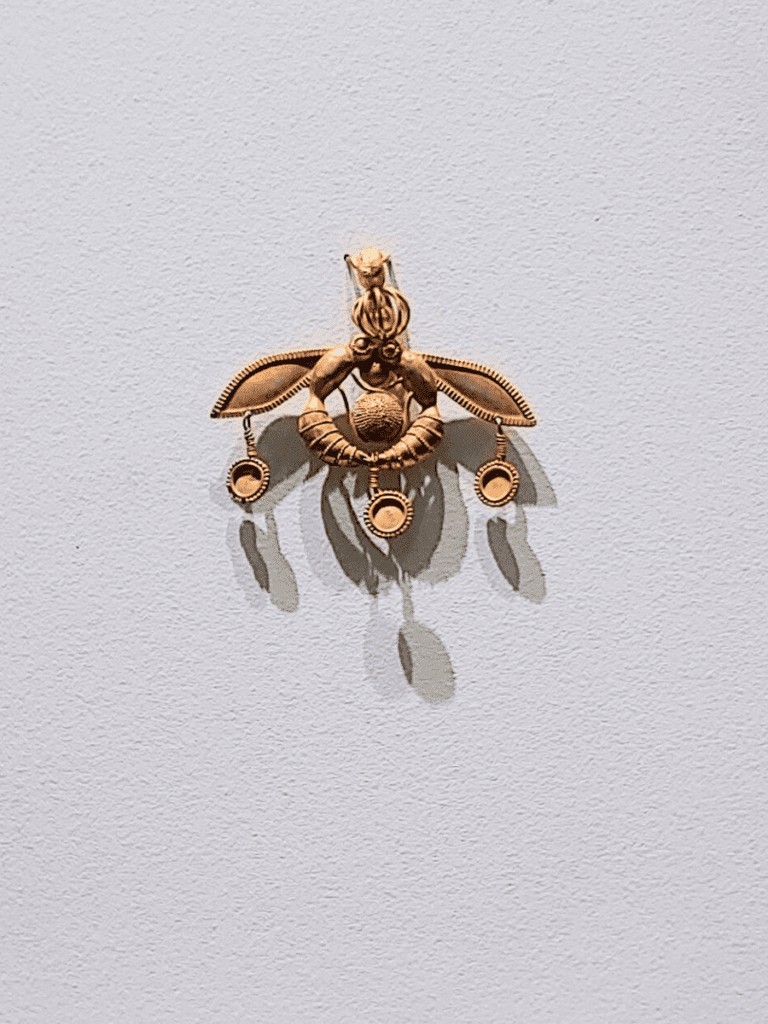
Perhaps the most famous piece of Minoan jewellery, French archaeologists discovered this stunning gold pendant in 1930 in Malia, in the ancient necropolis named Chrysolakkos, which means “pit of gold”. Honey and wax were essential elements of the Minoan economy and everyday life, and bees appear to have religious significance.
According to the audio tour, the bee was a symbol of the Minoan-Mycenaean goddess Potnia, which means “mistress”, who was also referred to as The Pure Mother Bee. The bee was believed to be born from the bodies of dead bulls and represented the soul and rebirth.
Beetles
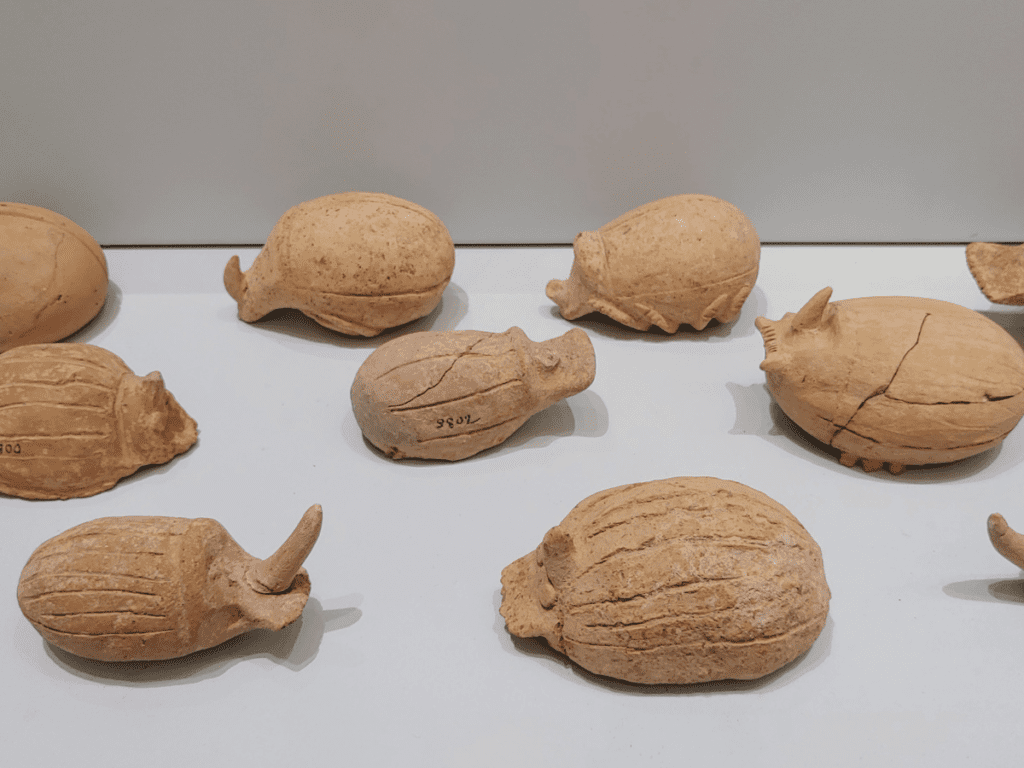
The numerous clay models of beetles were new to me. These are rhinoceros beetles, a subfamily of the scarab beetle family. Large numbers of clay beetles have been found in open-air and peak sanctuaries. The museum description says they were probably votive offerings connected to the Minoans’ prayers for the fertility of the land.
Funerary rites
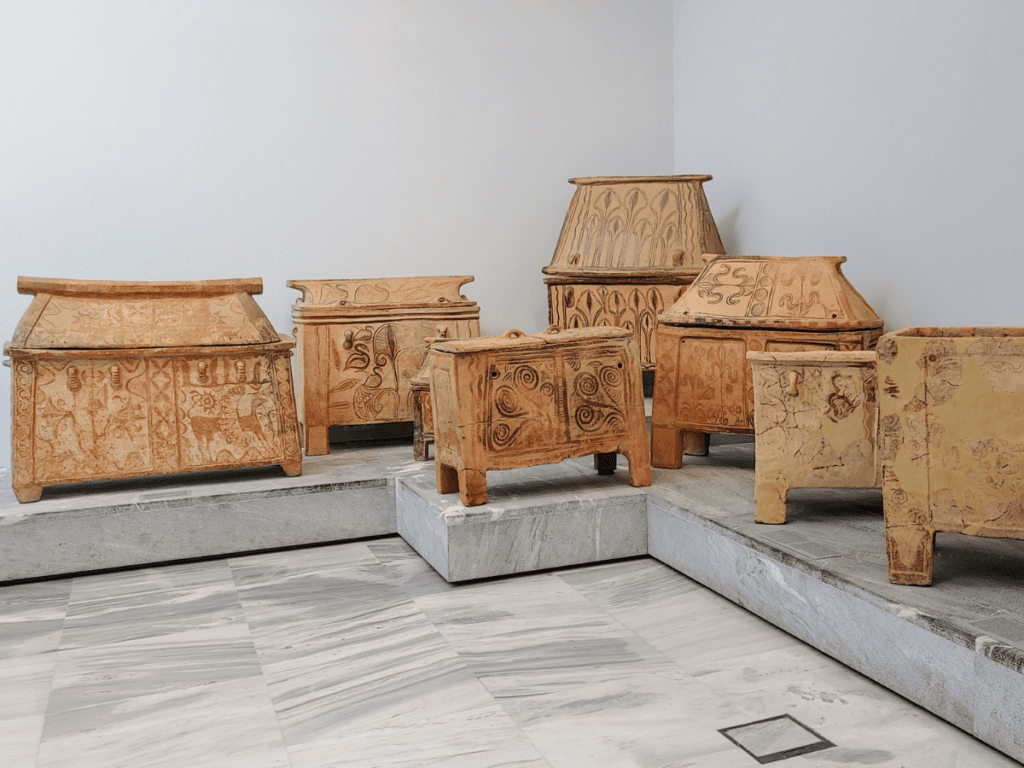
A larnax is a closed container used as a sarcophagus. Larnakes were richly decorated with symbolic themes, usually depicting the ceremonial journey of the dead and the presence of the goddess.
The clay chest larnakes shown here are painted with geometric motifs, flowers, nautiluses, the double axe, horns of consecration, griffins, and male and female figures representing the deceased, worshippers, priests and priestesses, and the goddess.
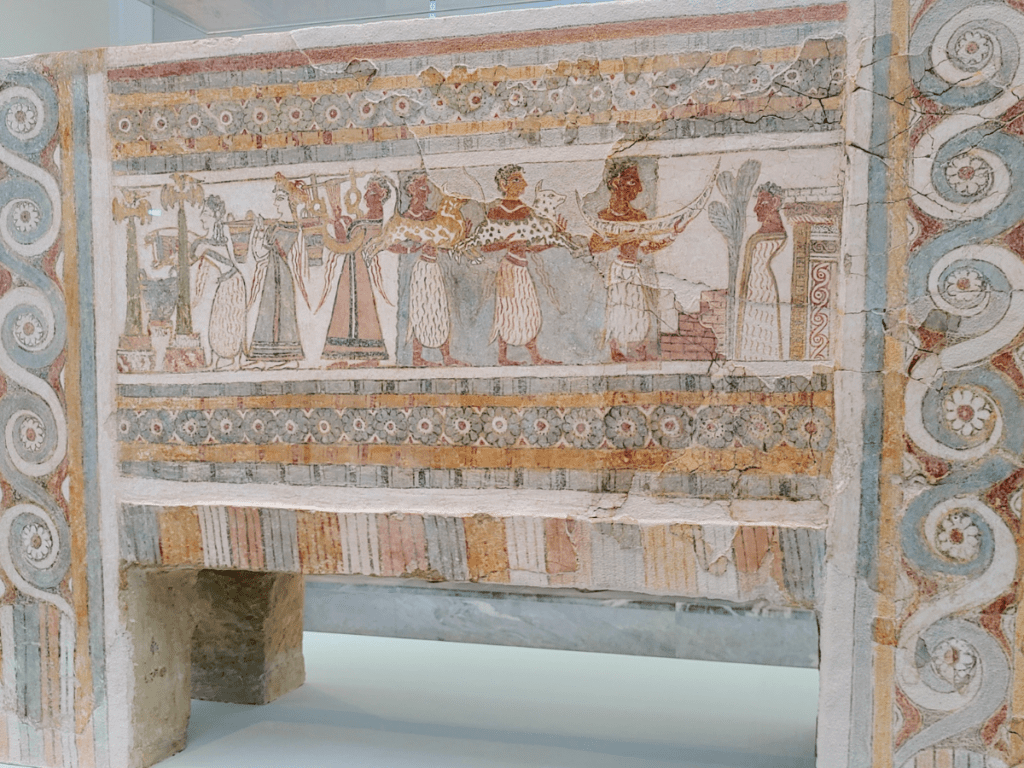
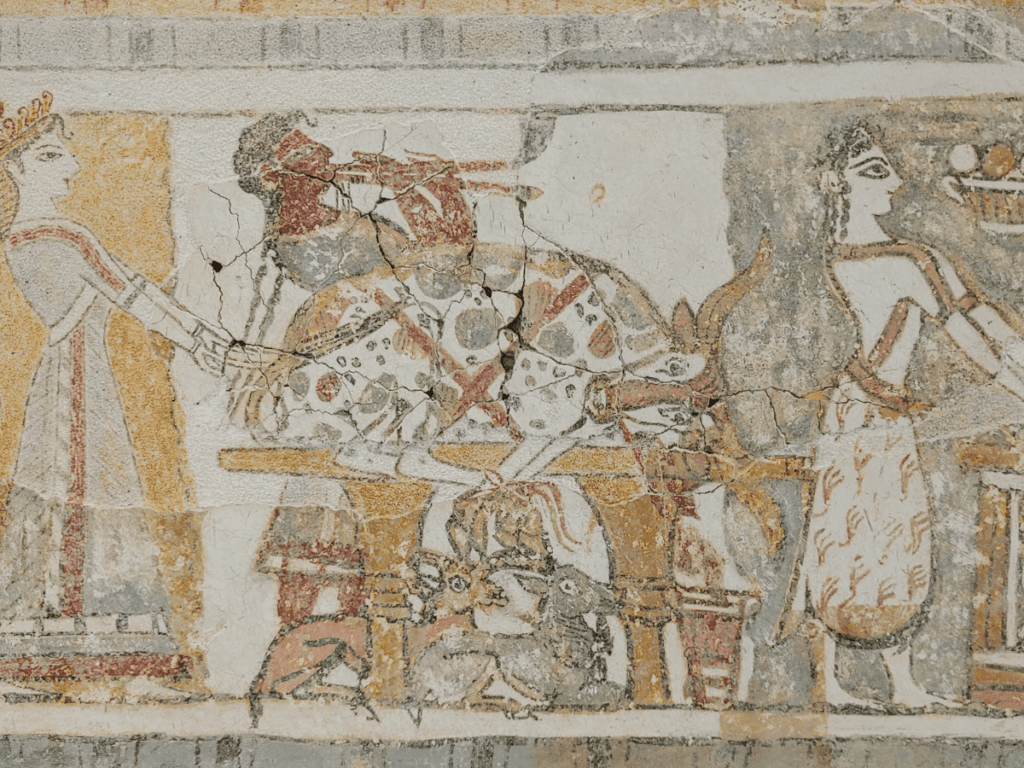
The Agia Triada Sarcophagus is a stone larnax with a thin coat of plaster painted with a funerary ritual. On one long side, it shows the deceased man standing in front of his tome, receiving offerings of models of animals and a boat. Priestesses pour libations between poles surmounted by double axes. The other long side depicts a bull sacrifice and bloodless offerings at an altar in front of a structure with a sacred tree. The two narrow sides depict figures in chariots drawn by wild goats and griffins.
The material, quality of construction, and iconography of the Agia Triada Sarcophagus indicate that it was used for the burial of a particularly eminent person.
More beautiful artefacts
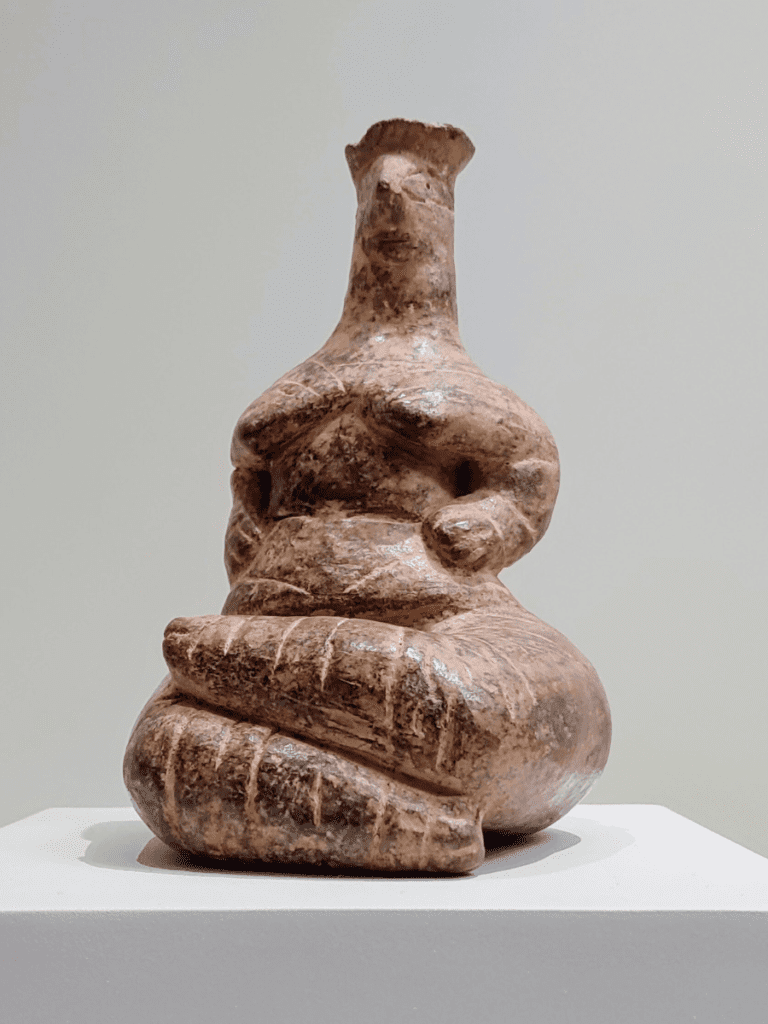
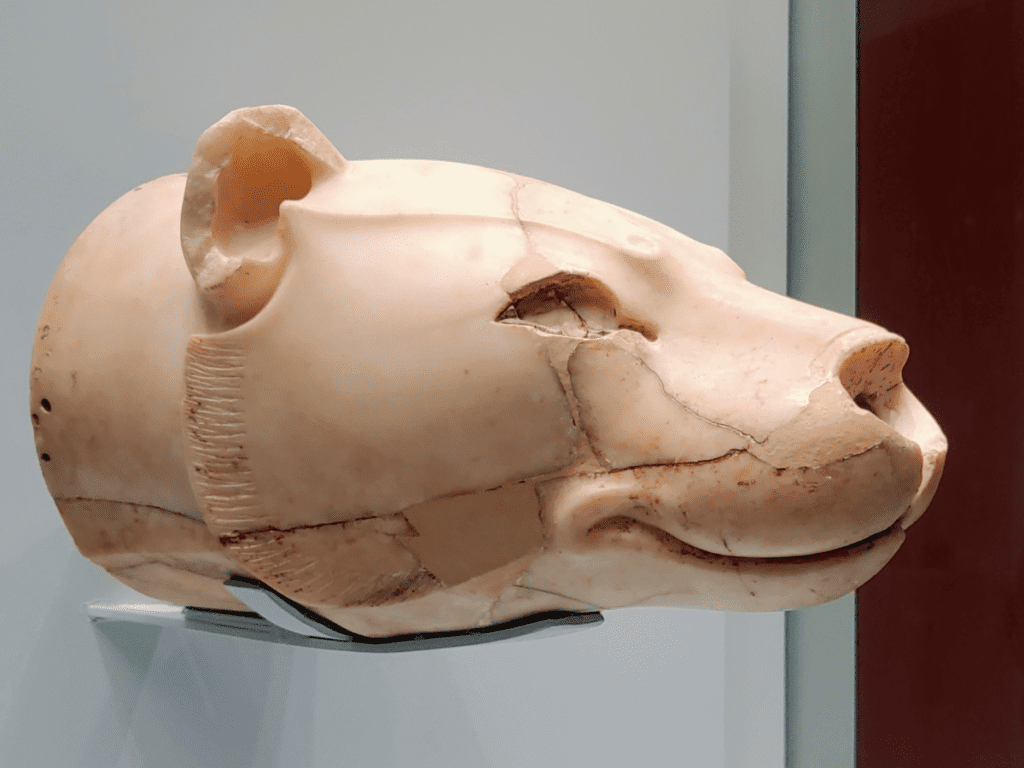
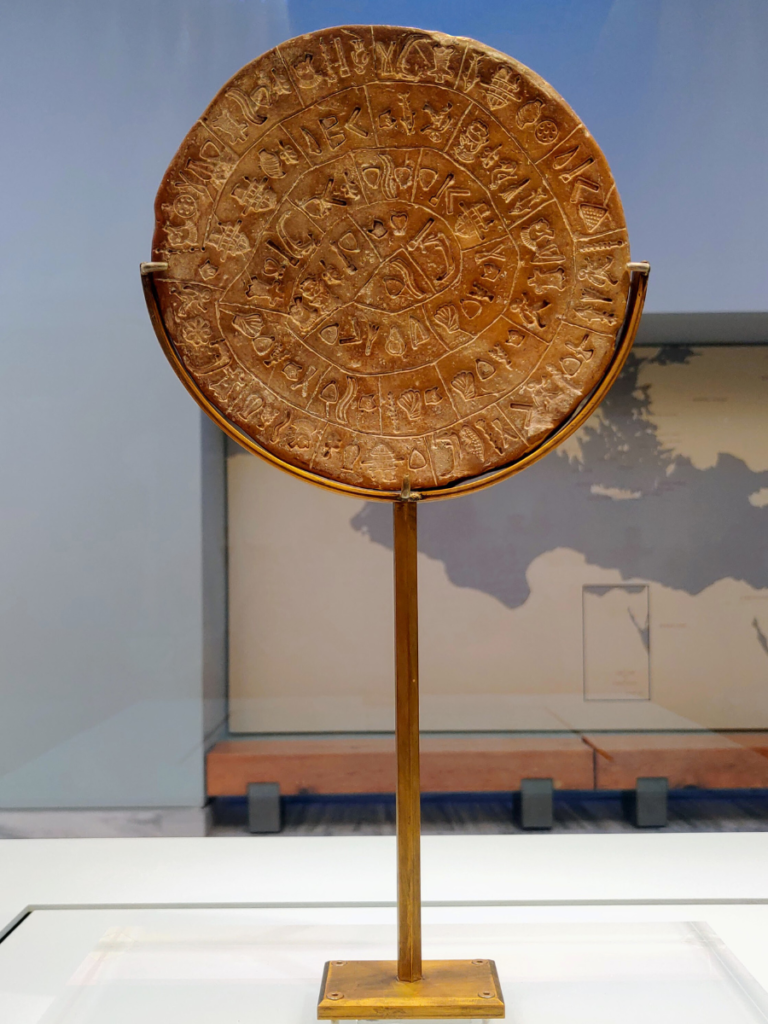
In 1908, Italian archaeologist Luigi Pernier discovered an intact clay disc while excavating the Minoan palace of Phaistos. According to the audio tour, it dates to the 17th century BCE, but scholars debate its dating.
The Phaistos Disc is 16.5 cm in diameter and 2.1 cm thick, with both sides bearing 241 tiny signs arranged in 61 groups, presumably representing words, but it has yet to be deciphered. The repetition of certain groups of signs points to the inscription being a hymn or incantation.
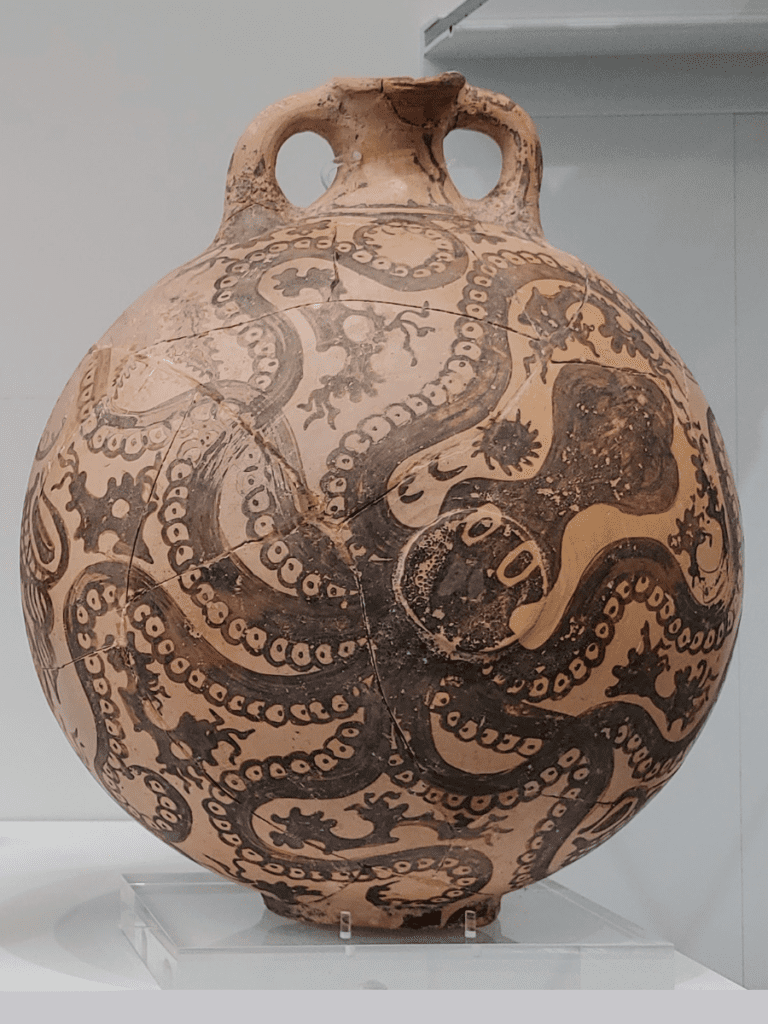
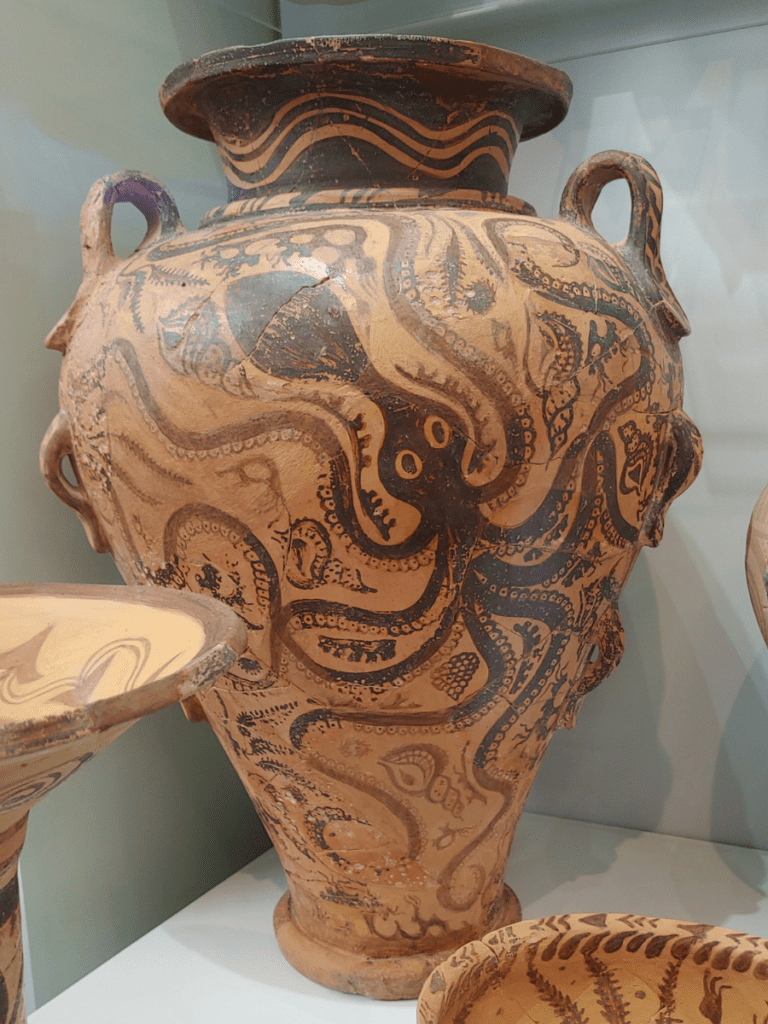

The free-flowing Marine Style featuring octopus, fish, and dolphins against seaweed, coral, seashells, and sponges is my favourite Minoan decorative style. I had to share a few of my favourite pieces featuring the whimsical wide-eyed octopus.
Kamares Ware
The krater with the relief lilies shown below belongs to a set of luxury vessels used in banqueting ceremonies of the ruling class. This vessel is quite large, not something you hold. It may have been used to mix wine and water.
Kamares ware is a distinct type of Minoan pottery with elegant shapes with themes in red, blue, and white painted on a dark background. They have chequerboard patterns, spirals, and stylised floral images. They owe their name to the Kamares Cave, where, in 1864, some of the finest examples of Middle Minoan pottery were recovered, but this kind of potter has also been found in mainland Greece and the islands, Egypt, southern Italy, and the Levant.
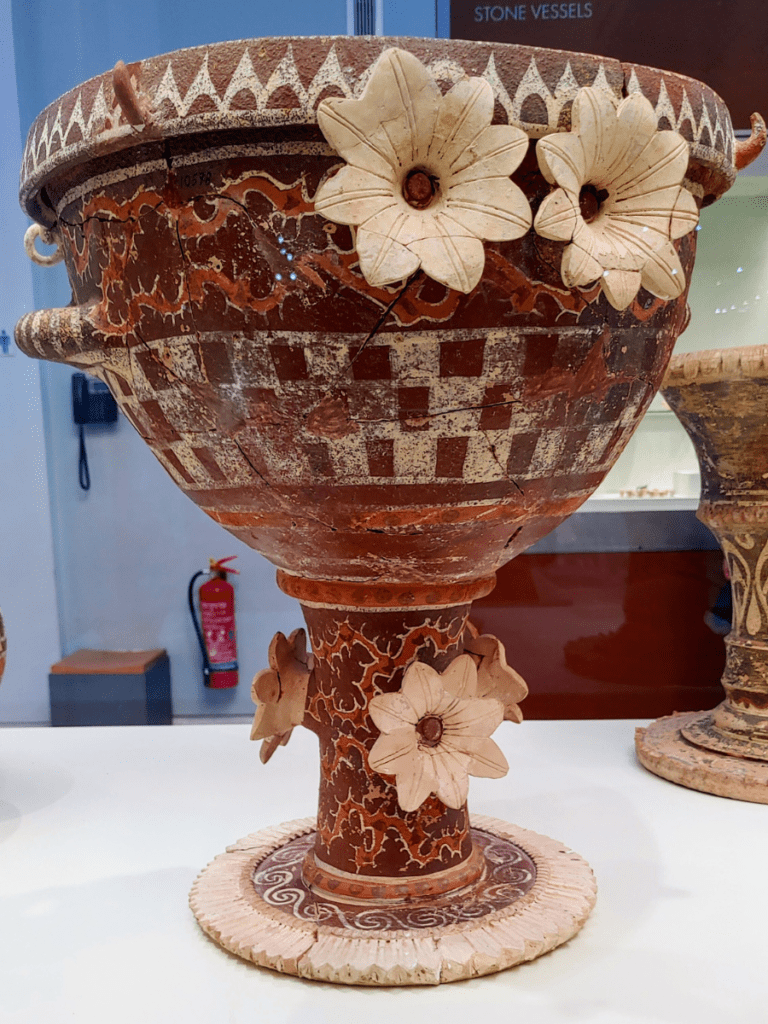
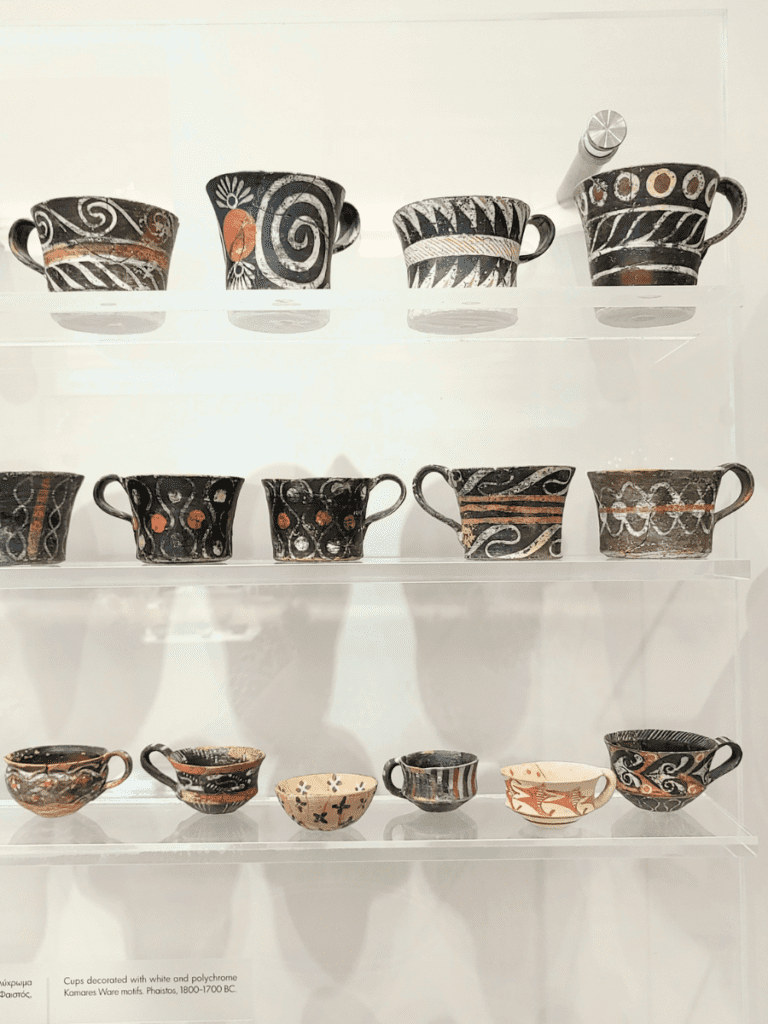
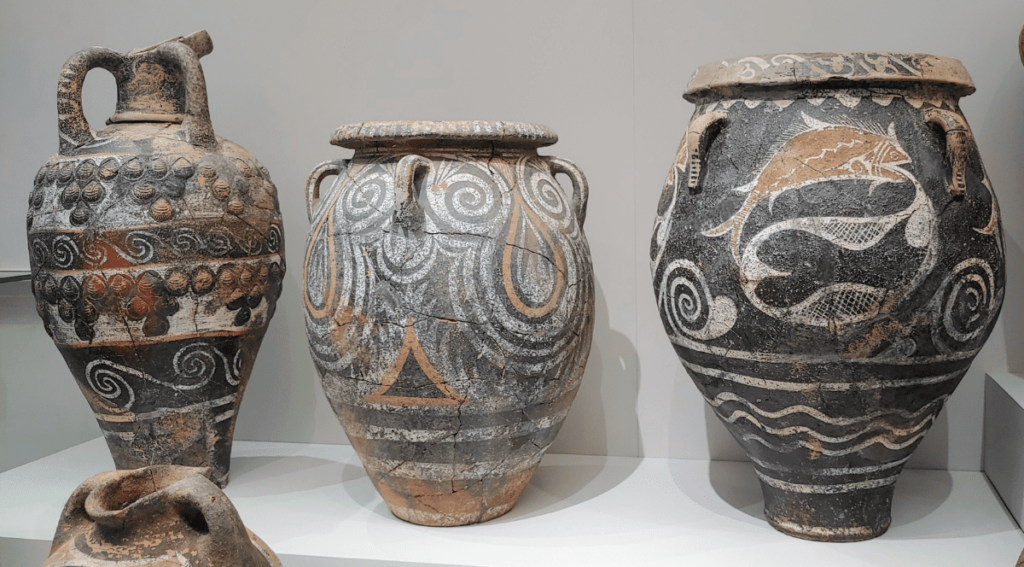
My husband and I took about 200 photos at the Heraklion Archaeological Museum. These are my favourites concerning Minoan religion (and a few others). Whether it’s including a sacral knot to your ritual wardrobe, incorporating ritual gestures, or adding new symbols to your sacred space, I hope it provides insight and inspiration for your modern Minoan Paganism.

